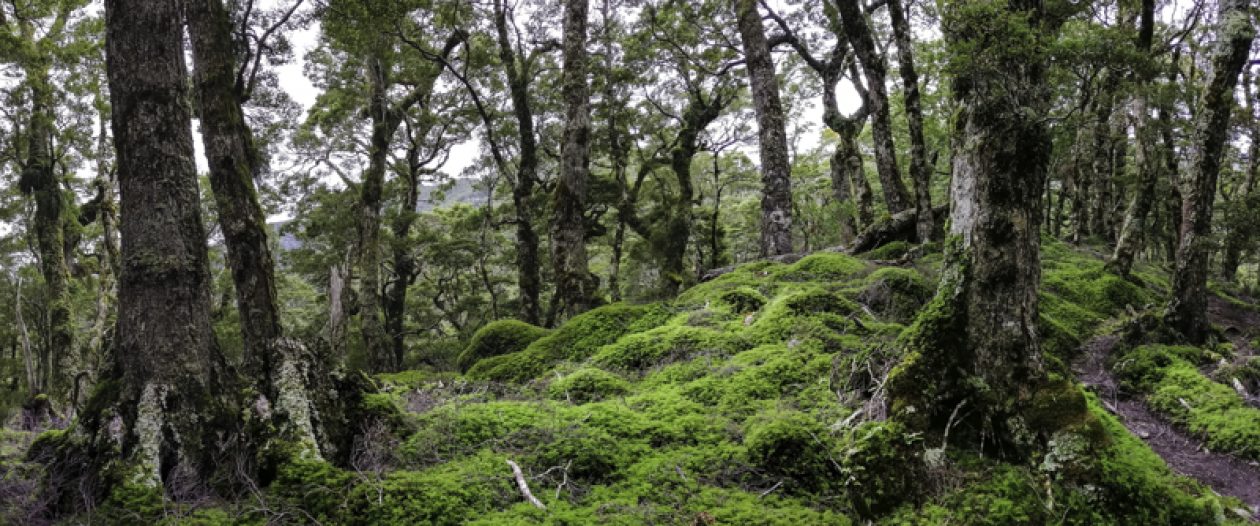Table of Contents
- Introduction
- Chenai, Tamilnadu
- Puducherry
- Mahabalipuram
- Kanchipuram
- Vellore
- Katarikuppam (ceremony)
- Gangaikonda Cholapuram
- Thanjavur
- Madurai
- Palani
- Kodaikanal
- Kodaikanal – Poomberai Village trek
- Coimbatore
- Mettupalayam
- Mettupalayam to Coonoor (Nilgiri Toy train)
- Coonoor
- Ooty
- Mysore, Karnataka
- Bangalore
See my South India photos
Introduction
This journey, in late July 2018, came about when my Dad and three brothers planned to travel to Tamil Nadu to commemorate our ancestral family. It was held in Vellore, about an hour from Chennai. This is the first time I had joined them. I had travelled to several countries including twice to India. However, I did not have the urge to discover my roots. The last time I was in Chennai was in 1966, as a seven year old, to see my grandfather in the village – Vandavasi. The only memories I have of this epic journey – my grandfather had a small sundry shop along a dusty and uneven road. I remembered the fish shaped coloured candies in his store; sugar cane trucks passed the shop very slowly (due to the uneven road). We ran after it, pulling out a cane or two; there is a small lake or pond nearby where the locals would do their washing. That’s it.
We travelled to India by a passenger cum cargo ship. We slept on top of the giant cargo hold doors. The holds are loaded up with an assortment of goods. As the doors declined slowly, we scramble with our mats to secure a spot. It was a six-day voyage. It had taken me almost fifty years to return to my roots. It is time to re-discover my Dravidian heritage and Tamilian culture.
The Tamilians are very friendly and helpful people. They are “gentler” and accommodating. Throughout my journey, I did not encounter a single negative “character”. Someone whom will push just to make a sale. It was never about money. This is in contradiction to my experience in the north, particularly Delhi and Agra. This journey had also enlightened me in the richness of the Dravidian culture and heritage – mainly its incredible and beautiful temples – ancient Hindu epic stories carved in stone, their beliefs and traditions. To be humble. The added benefit of travelling in Tamil Nadu is speaking the language – Tamil. It allowed me to interact freely with the people and their insights – the fisherman, the flower market traders, the onion sellers, the manual street worker, the auto drivers, the garlic farmers and so on.
This 25 days journey enabled me to see and reunite with relatives I had not met before and fulfilling a family ritual (that pleased my dad as well). Furthermore, This is the first time I had travelled with three brothers. I like to be free – go everywhere and anywhere at any time. It turned out to be fantastic and most times, hilarious. Everyone did what they had to do. We stayed in fabulous hotels ( when I’m alone, it is mostly budget travel). They love shopping. Although we had been together for ten days, this had been one of the highlights of the journey.
Travelling in Tamil Nadu is not touristy but with locals bee-lining to iconic temples and parks. Patience is virtue here and it all seems like a celebratory atmosphere, and you are invited.
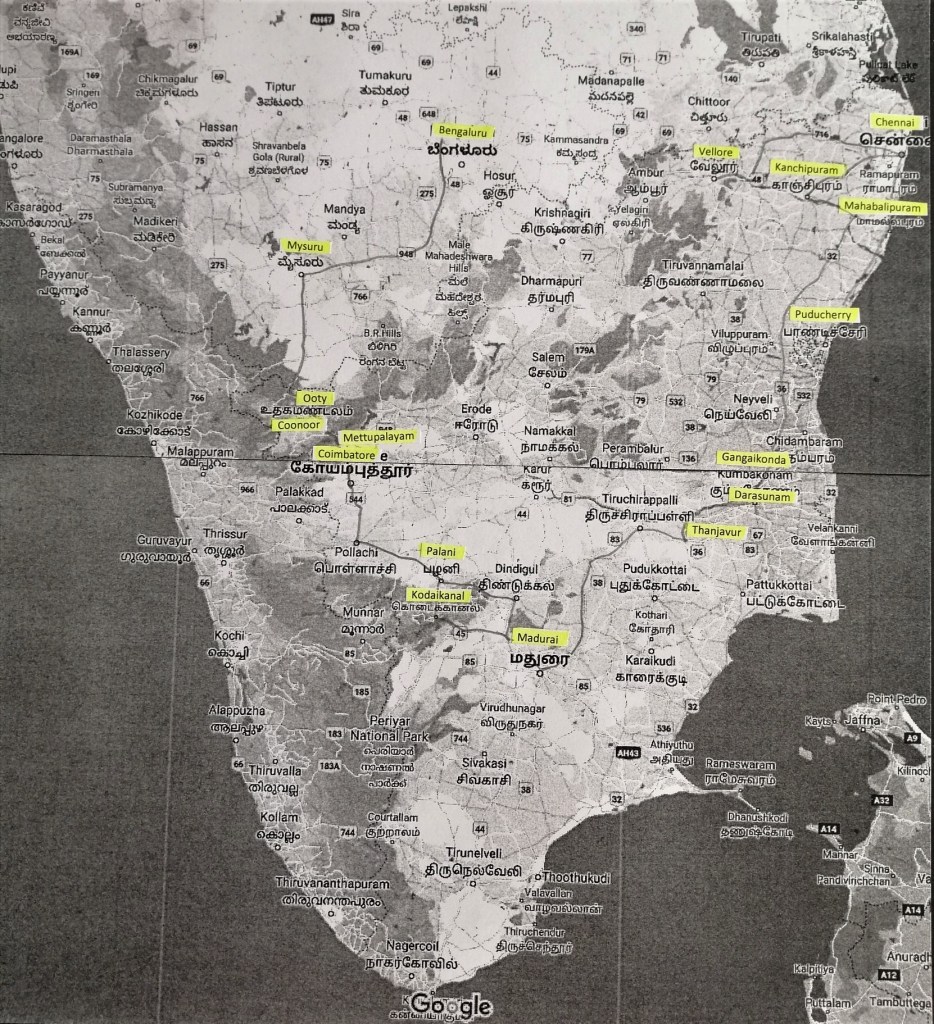
29/7 – Chenai, Tamilnadu
I arrived in Chennai (formerly known as Madras), the capital of Tamil Nadu State, with my dad and we were met by my uncle (dad’s brother). I handed my dad to him and I took off on a fast taxi (550 Rs) to my accommodation in the old part of Chennai – Mylapore.


It was end of July and the weather was hot. I loved walking in new places. As a Tamil speaker, I felt right at home. However, the heat here was intense combined with heavy traffic and smog, as I walked along the busy Ramakrishna Mutt Rd to locate the iconic Arulmighu Kapaleeswarar Thiru Koil (temple). First order of the day – lunch and the perfect place to start was Saravana Bhavan (a chain vegetarian restaurant). For lunch, I choose – Limited Meals with Filter Coffee (130 Rs). The place was crowded and it’s a good sign. The dishes were delicious. I finished off with sweet treats and filter coffee.

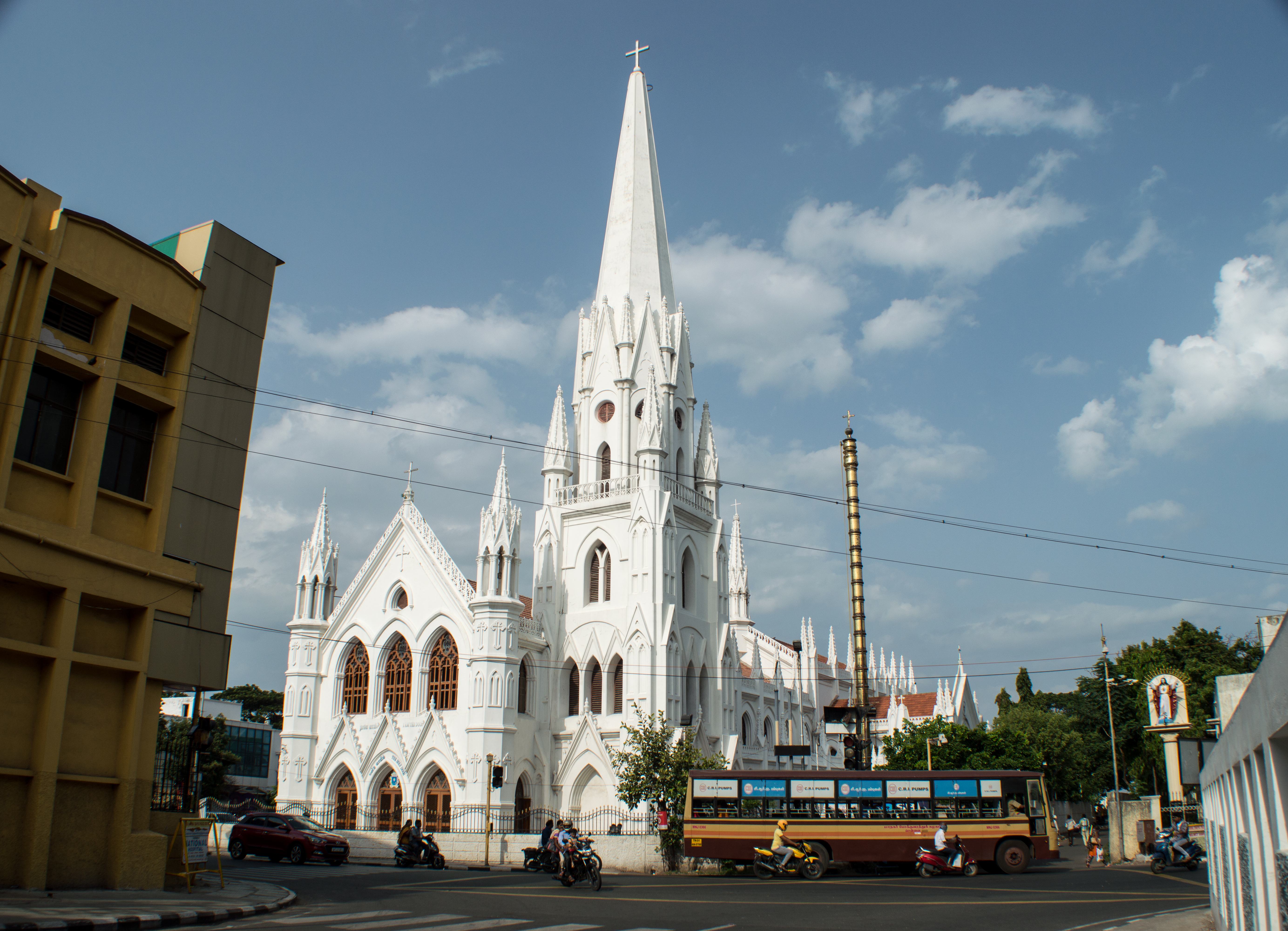
North Mada Street was littered with glittery jewellery shops. Opposite the temple, flower weavers were busy making garlands in this hot afternoon awaiting evening prayers (starting 1630 to 2130).
Along the way, I bumped into Vengathes, an auto driver from Vellore and his shy mate, Guna. They too were resting inside their auto rickshaw to get away from the heat. On Kutcherry Road, I spotted Mylai – a biryani specialist. Hordes of people queued to buy his meal – just rice with egg and chicken pieces. In fact, all the biryani eateries here are operated by Muslims. You know there’s a biryani stall nearby by the sound of the spoon knocking against the giant metal pot (with each serving).
This is a leafy road with matured Neem, Flame of the Forest and Mango trees. The shade was god-sent in today’s sweltering midday heat. This is a Muslim Quarter with several Muslim eateries and a mosque. At the end of this leafy street is the brilliantly white San Thomas Basilica (Santhome). The design is Gothic with wooden ceiling panels. A miraculous intervention is required to focus and contemplate God. Why? There is continuous din from the traffic honking and the noise from the automated counter for the traffic interchange. Sweat dropped onto my notebook as I write. No respite for the pious either. St. Thomas’s tomb is in an adjacent building. Unlike the furnace-like atmosphere, here it is air-conditioned and quiet in an underground chamber.
In the evening, I walked the periphery of the iconic Kapaleeshwarar Temple – King of Ascetics (built around the 7th century). There are several legends about this temple in Mylapore. Even Ptolemy, the great Greek philosopher (AD90-168) wrote about this temple. Footwear is prohibited. The pyramidal gopuram (tower) in distinctive Dravidian style is impressively decorated and painted with numerous motifs. It is the first thing that drew my attention. Soon, I went into the routine of prayers amongst the various shrines. This is a Shiva temple. The inner sanctum is decorated with gold plated brocade and artworks. Non-Hindus are prohibited.
Mylapore is a working class suburb of the greater Chennai. Streets are narrow and packed with vehicles and foot traffic. Some business are only a box of 2m x 1m. It is noisy but lively. Interestingly, there is little annoyance amongst the locals and everyone tolerated the situation as it is not going to change. Not worth the energy arguing – seems like a common philosophy here. It is quite a contrast from northern India. No one hassled me to buy things or tell me what I should be doing and seeing. In short, the Tamilians are more civilised and respectful. It is early days, I shall see!
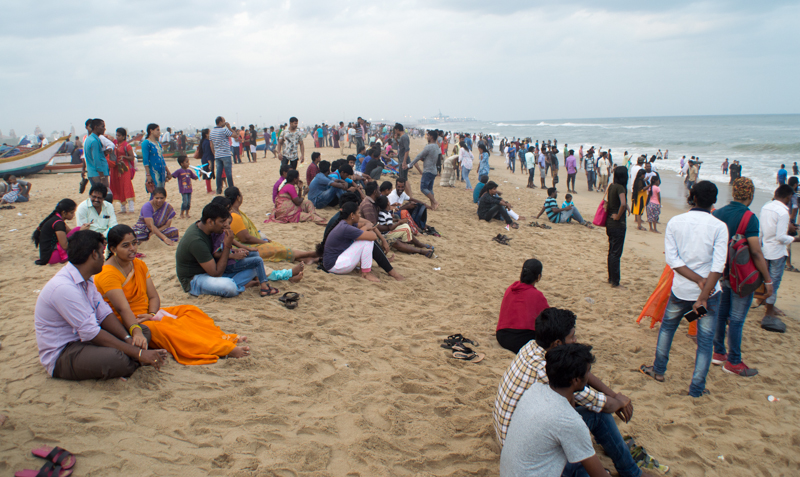
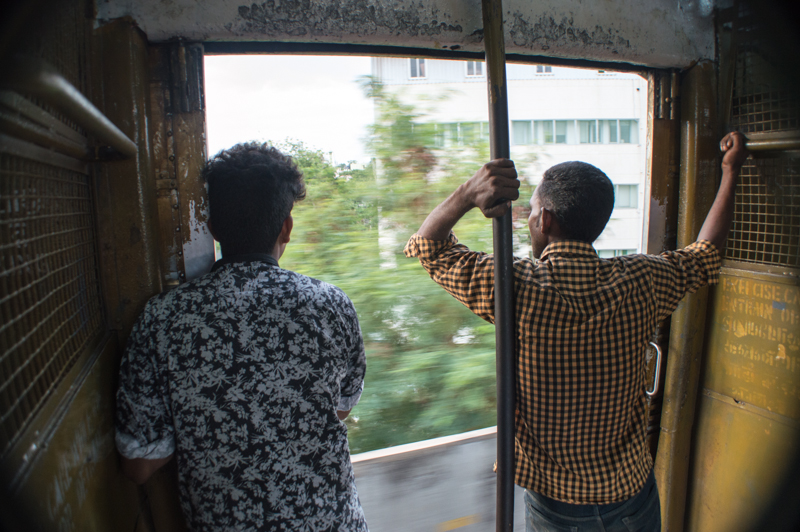

This evening I headed to a popular spot – Marina Beach. A metro train from Mylapore brought me directly to Marina Beach. Interestingly, these trains have no doors. It is great with the wind cooling the insides but disregarded health and safety. The beach was crowded. There were a few eateries and a few playground- type activities. Flies seem to sit on all food and that put me off from trying any. Both young, elderly and families sat or wandered on the beach. Swimming Indian style- go in dressed as you were! A street food dinner at Mylapore – thosai pizza!
30/7 – Chenai
Early morning, I caught a bus to Parry’s Corner (Gorgetown), near the Madras High Court. From here, an auto (100Rs) to Kasimedu Fish Market, past Royapuram town. We exited into a narrow lane. On either side, cold storage facilities were busy with today’s catch. Blocks of ice were shifted around into these dingy stores. An assortment of fish, prawns and squids were packed with ice. The lanes, saturated and clogged with water, zig-zagged towards the wharf.


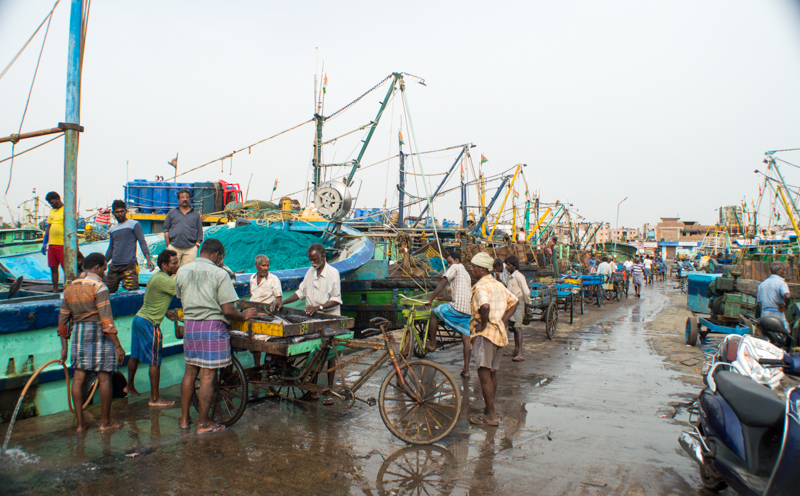
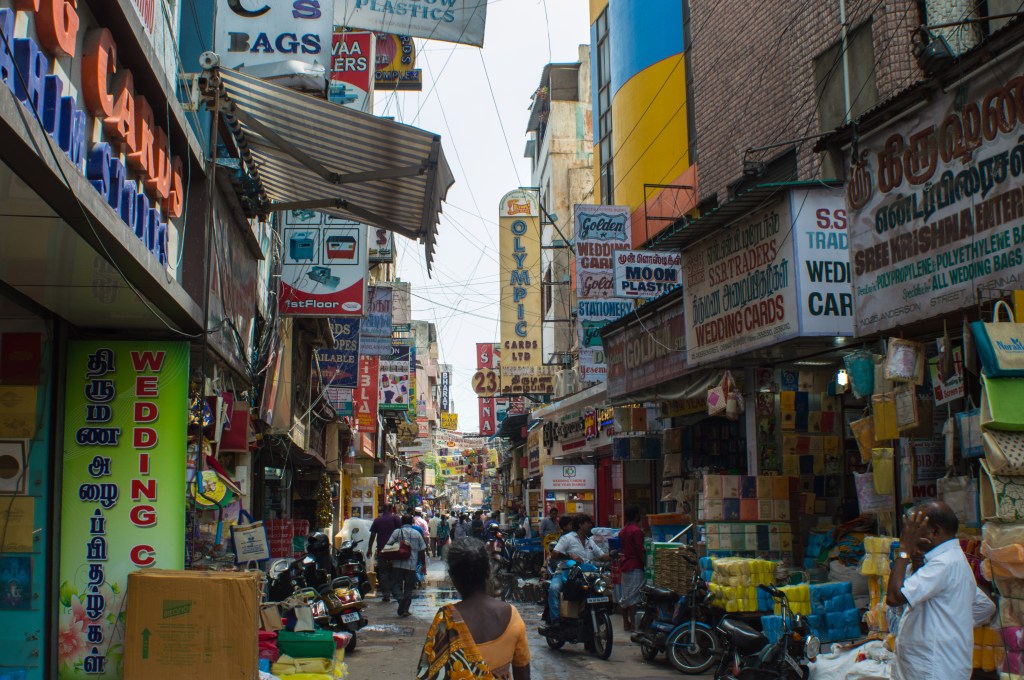

Fish auctions were in full swing. I noticed mainly women dressed in bright colourful sarees. Potential buyers bid fiercely until the auctioneer repeated a price thrice. Then it is sold. Buying and selling is brisk and frantic. After the sale, everyone relaxed and chatted. Battle-lines are only drawn during bidding.
Smaller fishing boats anchored near the wharf while the larger trawler were some distant away. The trawlers were still unloading some of their catch. It was a hive of activity – workers mended damaged nets, cleaned and washed the boat decks. Others, just catching a breather before their next voyage.
One trawler was just unloading sailfish. This bunch were a jovial lot. There was one huge with several average sized. The fishermen had been out at sea for seven to ten days. They are off again after two to three days. It is a tough job to earn a living. They transferred all the fish from the boat’s hold onto a wheeled cart. It took about ten men to move one large fish. I followed them to a cold store. These middle man specialised in sailfish only. The fish is weighed and transferred into cold storage trucks. Today, there were about 8 – 10 fishes. The heaviest was 220kg. The boss told me that they can get to 300kg.
I returned to Parry’s Corner in Georgetown. Breakfast was on my mind and soon spotted Murugan Idli, a chain restaurant. Their hot idli is a treat. Satisfied, time to explore Georgetown and Sowcarpet wholesale markets. It all began calmly at the old Armenian Church, opposite Murugan Idli. It is a tranquil place. Across the wide street, I popped into the red Madras High Court. Solicitors and Barristers briskly walked to and fro with their clients bewildered with the going-on.
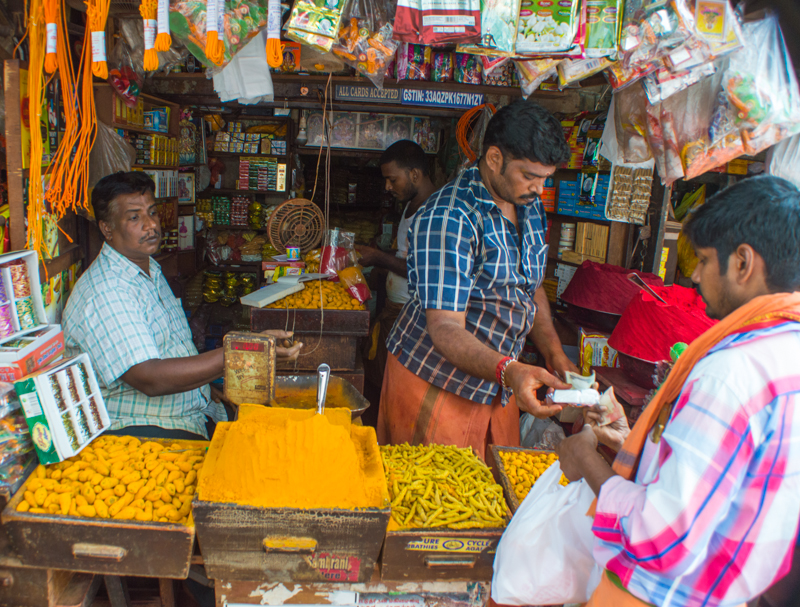

Chaos began the moment I entered NSC Bose Road. I was swept up by the foot and road traffic. At times, I lost control of the direction I wanted to go. The roads were packed to the brim with cart wheel trolleys, auto, cars and people. It was a riot of business ranging from household goods to sundries; fresh produce to ornamentals; electrical to small machinery. On certain streets, even pedestrians were brought to a standstill. However, I loved the atmosphere, frantic calls by paddlers to sell their wares and money exchanging hands. Some streets dealt with a particular product. This is the real local economy. These are the wholesale markets of Chennai. The flower market was vibrant with colours, perfumed aroma and brisk trade. People are friendly. I got talking to some. They don’t mind being photographed, if you asked.

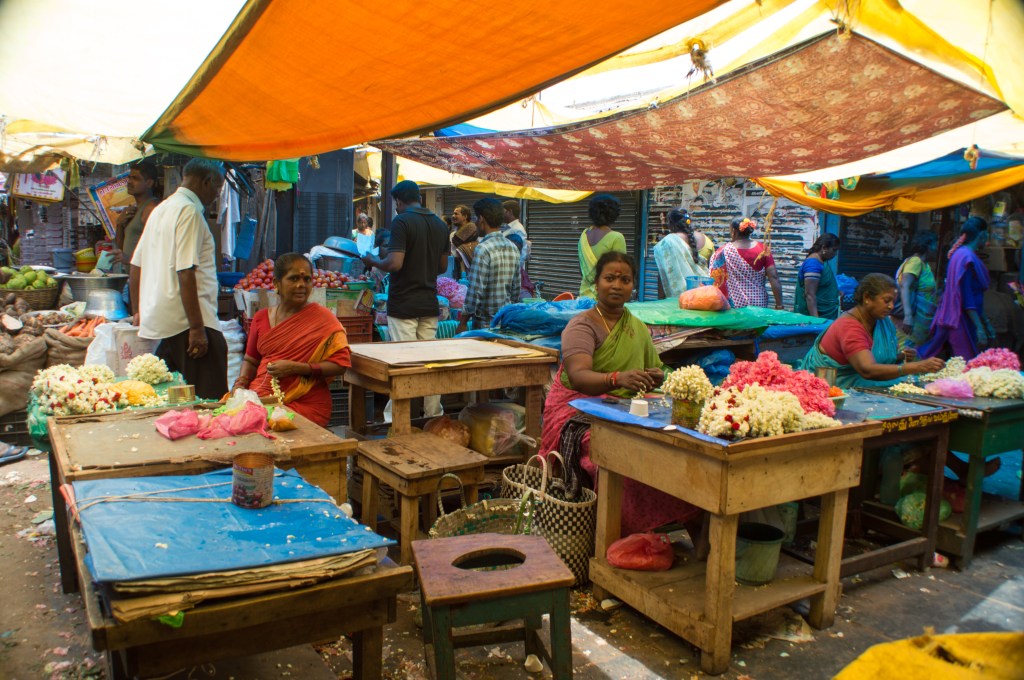
Although voices are raised when the streets and lanes are packed, there is nothing malicious. Little remarks are passed in playful jest. Everyone understood that they all wanted to be somewhere. That was amazing. To get reprieve from the afternoon heat, I headed back to Murugan Idli for lunch. It was cool and also a chance to get away from the crowds. Then straight into Mint Street, mostly with filled with jewelries, bangles and all sorts with bling. Eventually, I ended up at Chennai’s Railway Station.
This evening, I went out looking for some traditional or classical dance (Bharatanatyam) shows. There was none but managed to see a singing show at Bhartiya Vidya Bhavan nearby. Today’s show was narrative and songs about Kapleshwarar Temple. It was free, air-conditioned and the seating was fabulous. I enjoyed the show.
31/7 – Puducherry
With the hostel guys direction, I caught a bus (ECR bus – point to point (160Rs) ) to Pondicherry. Buses are infrequent and schedule uncertain. Surely there will be one. Arriving busses were full. Finally, I managed to get one with seating.
Arrived in Puducherry around 11am. Clouds in the sky today made the morning cooler. Headed off to Courbet Market (Big market). I love markets. A place to gauge the economic activities and daily lives of people. Plus, the colours of a market places is amazing. There are rows and rows of products including – fresh vegetables and fruits, flowers, metal works and ornaments, sundry supplies, meat, fish, onions, banana shops and lots more. One item that caught my eye is the colourful organic pigments heaped on benches. Wandering aimlessly is quite invigorating. Shop keepers are always busy negotiating prices for their wares. However, they are easy to talk to. Most oblige like Majid, the coffee boss and Bharat, the banana seller. A smile may be harder to come by. Perhaps the heat or keeping one eye for potential customers.


I headed to Hotel Surguru for lunch. It was crowded and a good sign that the food will be good. It is a vegetarian place and the special thali is a big spread with tomato soup and ice-creams as specials. Most of the patrons were foreigners. It is a little pricey perhaps for the locals. The food was delicious. Restaurants are sometimes referred as hotel.
Pondicherry has a deep colonial past particularly the French. Hence, a French Quarter or White Town was established. There is a small French community still living here assimilated with the Indian society. This is a leafy part of town with brightly coloured colonial architecture neatly arranged in a grid style. Most of the buildings remained silent and other converted into accommodations, eateries and cafes. It is pleasant place to wander with the occasional sea breeze. Towards the coast is a promenade (free of vehicles in the evenings). A few people braved the afternoon sun and cooled down in the Bay of Bengal.
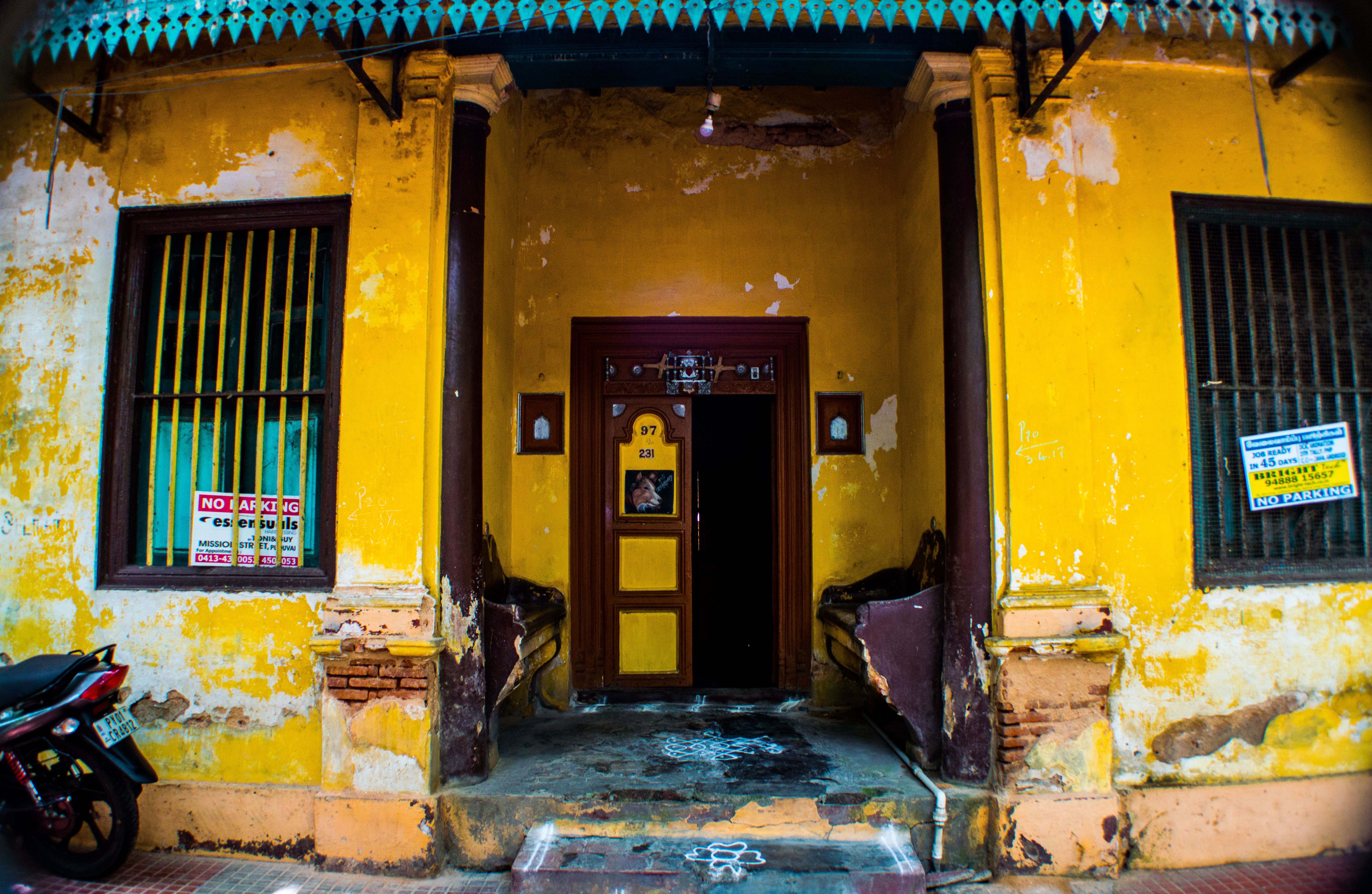
Aurobindo Center is a quiet place for retreat and reflection. It is also a place to watch squirrels hopping around, an owl on the tree keeping an eye on the proceeding below and crows cackling over scraps. Later in the evening, visited the Vinayagar Temple. An elephant granted blessings at the entrance. The interior of the temple walls are adorned with gold and lots of it!
1/8 – Mahabalipuram
After a fantastic breakfast of Idli and Vada, I was ready to head off to a unique ancient site – Mamallapuran (Mahabalipuram). Caught the ECR bus (Rs 110). Although it stops regularly, it was good. It does not go into town but stopped on the main road. I caught an auto (Rs 60) into town.
Mahabalipuram lies on the Coromandel Coast which faced the Bay of Bengal. The town is divided into two – the Indian side and the tourist and heritage side. On the tourist side, where most accommodations are, comes with all the trappings of foreign tourism – souvenirs stalls selling from carved stones, scarfs, T-shirts and artefacts from all over India. The streets here resembled, in a small way, to Thamel area in Kathmandu. My accommodation is basic, a cement bed with mattress. Just for one night.
Mahabalipuram is a UNESCO Heritage site with monuments dating back to 7th and 8th century built during the Pallava Dynasty. This included rock-cut temples, stone bas reliefs and cave sanctuaries. I arrived here at 1pm. Soon, wandered on foot to explore the delightful monuments.
First, I headed off to the Pancha (Five) Rathas. The road leading to this monument is stacked with stone masons and carvers. A myriad of statues lay stacked in the compound and sometimes spill onto the road. The sound of someone grinding or chiselling away is constant. The monument is 1.5 km from my hostel. Entrance fee of Rs500 included the Five Rathas and the Shore Temple. (for locals, it cost Rs30).
The site is very impressive. It is unbelievable that the collection of monuments were carved out from one single sandstone monolith. Five different structures with various motifs intricately and delicately carved – is a sight to behold! The intricacies and precision carving over 2000 years ago bears witness to the skills of the architect and artisans. Using basic tools, they created a masterpiece that lasted till today. Deities carved in likeness with demi-gods adorn the interior and exterior telling a story from the past. All based on ancient Hindu and Indian text. An outstanding examples of Dravidian art and architecture. Stories from the ancient text – the Mahabharata are carved in stone. The environment is quiet and with only a few local tourists. I need to read more about this monument.


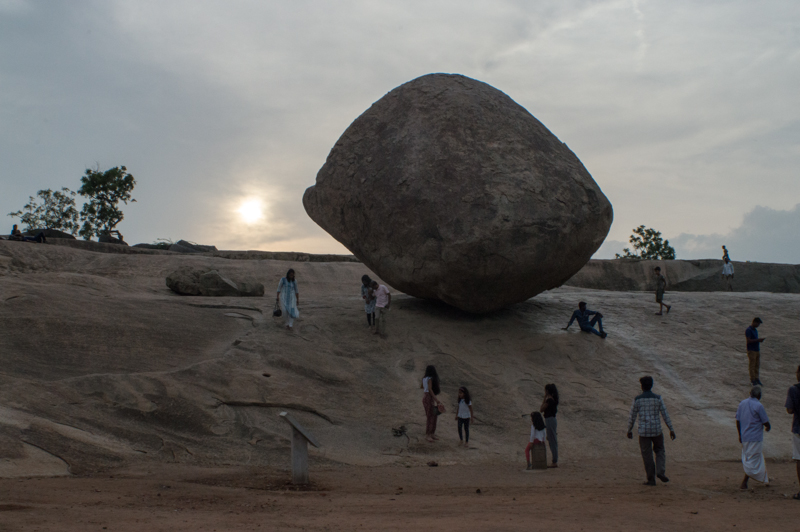
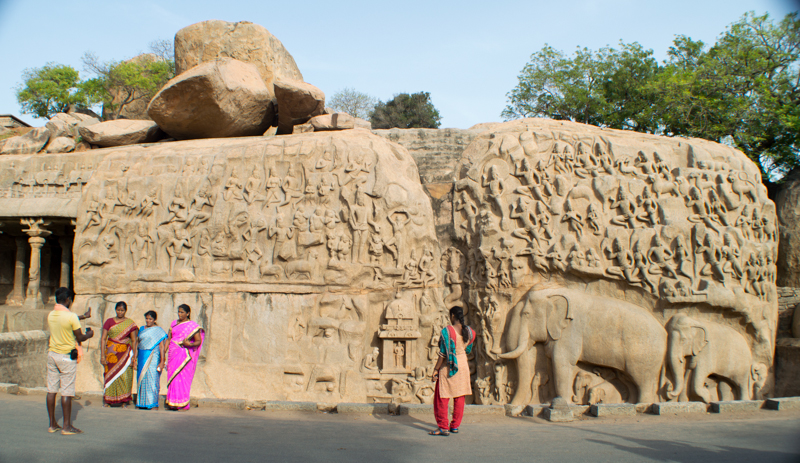

Rock cut Krishna Mandapam (7th century) – There is a wonderful relief of Krishna, cow herders, gopis (milk maids) and pastoral life. This is another great story told in stone – the locals were worshipping Indra, God of Rain, to give them the good life. Krishna disagreed and said, it is due to your hard work. Indra was not happy. So, it rained heavily and continuously. Krishna lifted his hand and put one finger to lift the symbolic Govaradhana Hill to protect the animal and people below. It rained for several days and eventually Indra gave up.
Decent of the Ganga or Arjuna’s Penance? – a great story……
The magnificent open-air bas relief is a Hinduism storytelling at its best. What do you see? The two interpretation, amongst others. I liked this one :–
King Sagar wanted to perform Ashwamedh Yagya to become Emperor of Earth. Part of the procession is to release a white horse. In whatever direction the horse goes, that land belongs to King Sager. However, Indra the King of Heavens did not like this. So, he stole the horse and brought it faraway and tied it to a tree beside the meditating Sage Kapil. He had no knowledge of this mischief. King Sagar was furious about the lost horse. So, he directed his sons and 60000 army to find the horse. Eventually, they found it next to Sage Kapil, still in meditation. Impatiently, they disturbed and accused Sage Kapil, as the perpetrator. Kapil was not pleased by all this disturbance. When he opened his eyes, he incinerated them with his fiery eyes. Only mounds of ashes remained.
King Sager was understandingly lost wondering what happened to his army. So, he sent his only son Anshuman. Eventually, Anshuman found Sage Kapil and the mounds of ashes that surrounded him. However, he waited patiently for the sage to come out of meditation. When the sage opened his eyes, he asked Anshuman what his purpose was. Anshuman explained and the sage instructed him to take the horse. What about my dead brothers? Their soul will not be reborn and only become ghost. Sage Kapil informed that only the holy waters of Ganga can purify and liberate the souls. You must bring Ganga from Heaven to Earth!
Anshuman left and relayed the message to his father, King Sagar. He left the kingdom to Anshuman and began to meditate to invoke Brahma to bring Ganga to earth. He failed and subsequent kings also failed. After seven generation, a son named Bhagirath took over. He too went into meditation to invoke Brahma. He succeeded and Brahma agreed to fulfil his wishes. However, he warned, Ganga is powerful and destructive. You must seek Shiva’s help to restrain her. So, he meditated to invoke Shiva and was successful. Ganga was coerced to go earth. Reluctantly she agreed and flowed down from heaven. Shiva spread his matted hair to soften the power and after a challenging journey, eventually arrived at Sage Kapil. All the souls were purified and liberated.
Hence, why Hindus worshiped Ganga and purify themselves in its holy water and for the souls to attain Moksha (liberation).
There are several rock-cut mandapam and temples dotted here and there over this rocky outcrops. One of the earlier ones included the Mahishamardini Mandapam and several caves. I met a man resting and pondering at one of the mandapam. I asked him, why some of the monuments are unfinished. His response was that too much money had been spent plus when the king lost his only son, he went into depression and the rule began to collapse. There are numerous motifs dedicated to Dhruga, Shiva and other gods like the Varaha Temple and Royagopuram. I climbed up to the top to Olakkaneswara Temple (8th century)- a Shiva temple. The views of the Bay of Bengal and the interior is spread out. Some of the reliefs are almost unrecognisable due to weather damage.

Shore Temple (700 – 728AD) – This Mamallapuram monument is idyllically located on the shores of the Bay of Bengal. The motifs are intricately sculptured and is one of the oldest Dravidian style structural stone temples of South India. The sculpted panels illustrate scenes from everyday life. The shrines are dedicated to Shiva and Vishnu. It is said there were seven temples with only one on land. The rest had been engulfed by the ocean. The 2004 tsunami did reveal this and myth had become fact. Strangely, the tsunami left this temple in one piece. Divine intervention perhaps! Silt and salty sea-breeze had taken its toll on the structures. Whatever is left is still magnificent and a wonder. An inspiring work of art from centuries ago.
Krishna’s Butterballs – a unique spherical shaped 250 tons granite rock precariously balance without toppling over. It has been in this state for centuries. A great place for people watching in the evening. There are a few temples and monuments nearby. I was monument-ed out!
2/8 – Kanchipuram
Kanchipuram, sometimes referred as Kanchi is an ancient town. Even mentioned in the epic Mahabharata as part of the Dravida Kingdom. It looked just like any other Indian city but is called the city of 1000 temples. In fact, Tamil Nadu has over 33000 temples. Kanchipuram silks is famed as one of the best. It was also the seat of power for the Pallava Dynasty during the 3rd century. It was also a place of learning – an ancient centre of education.
It rained when I arrived here by a local bus. I had no idea where my accommodation was. So I ended at the city centre. The auto man took me around the town and soon exited the city. I was concerned. My accommodation is on the outskirt. After settling in and my bearings restored, I was good to go. Rain or no rain.





The reason I choose this place was its proximity to the 3rd century Devarajaswami Temple (or The Varadaraja Perumal Temple). Kachipuram had been ruled by several dynasties – Cholas, Pallavas and the Vijayanagara. Structures were continuously added on by the different dynasties. The main gopuram is white with black granite base. There were a few devotees. I was drawn towards a large hundred pillared mandapam with intricate carvings along its side. I noticed that even the chain hanging from the ceiling was carved from a single stone. The detail and delicate motif never ceased to amaze. Inside the temple, there are aged but colourful wall murals. Each had a story to tell. I noticed that the top of the inner sanctum gopuram is covered in gold. Carved white pillars supported the ceiling with circular patterned motifs. Various dynasties had enhanced the beauty of this magnificent temple.
It was still raining and the storm clouds did not relent. With only one day here, I picked a few temples. I hailed an auto man and directed him to Kailasanathar Temple. Due to rain, I requested that he waited for me for my next destination. This is the old temple in Kanchipuram and was built in the 6 – 7 century during Pallava rule. The main entrance looked like made from sandstone. This is a Shiva temple. There are small caves within the structures, perhaps for meditation, along a courtyard. Mythological beast (lions) motifs seem to dominate the sculptures.
As I proceeded in a clock-wise direction, I was faced with a smallish mandapam and a long corridor of pillars and sculptures. Within each space between the pillars was a black Shiva lingam. I completed my outer circumbulation. I continued again just to admire the masterfully carved stone motif and murals. The gopuram is in a pyramidal shape.
A lone priest invited me into the inner sanctum. He spoke English. He conducted some prayers and later instructed me to enter an underground passage. This is the “parikarma” – circubulation of the inner sanctum. After climbing a few steps, I entered with some trepidation and squeezed through the narrow passage while conducting some manoeuvres. The movements and motion is said to represent death and re-birth. In Tamil is called “Karuvarai” – the Mother’s womb chamber). Now, I had died twice and re-born twice. The first was at Kailash Mountain in Tibet. A sense of calm and fulfilment prevailed. A similar feeling I had when I arrived at Mount Kailash.
My auto driver waited patiently for me. In India, there are always some kind of scam. Auto and taxi drivers included. I paid Rs80 from my out of town accommodation to Kailasa Temple. He said he would charge me Rs80 to get back to town (including waiting charge). Sounds reasonable, I thought. On the way, he stopped at various temples and explained its shrines and so on. He stopped at one obscure temple and told me to see the giant lingam inside. I did.
We carried on to Ekambareswarar Temple. I asked him the location of my next temple – the Kamachi Amman. It was nearby. I paid him Rs200, just Rs40 more than he asked and said I would just walk there. He was so grateful for that little extra and insisted that he would wait and send me to Kamachi Temple. So remember, not all are scammers. He was genuine, hardworking and humble. Perhaps, it is a South Indian thing!
Ekambareswarar Temple (Ekambaraanathar Temple) is dedicated to Shiva. There are four impressive gopurams. When I entered, I was awed by the work of the artisans – each pillar carved out of stone, decorated with numerous motifs and taking into consideration all the religious parameters in its construction. It was overwhelming. It was dark and dingy and some of the stones blackened from touch by millions of devotees over centuries.
The temple was initially built by the Pallavas (6 century) and continued on later by the Chola Dynasty. Along with my prayers, I was looking in amazement the various buildings and structures. At one place I was keen to take a picture. I asked a priest and he gave permission. It is the 1000 Pillared Hall. It was mesmerising. I had no idea where I was and continued around the large complex. I did find the mango tree in the centre in an open part of the complex. I did not understand the meanings of the various structures or their purposes or what they represented. All I know is that I was present here and now. There was a sense of peace and calm.

Daylight was fading fast and the rains had disappeared but dark rain clouds hung about. My final temple visit was the auspicious Kamatchi Amman Temple with the main shrine devoted to Kamachi Amma (Parvathi). It dates back 1600 years. As with most important temples, there are four gopurams located in the North, South, East and West directions. This temple is revered by the devoted. The smaller inner sanctum gopuram is made from gold. The water tank is centrally located. As per all other ancient temples I had been, I went into the ritual of prayer moving in a clockwise direction from one shrine to another until the inner sanctum. As the same time admiring the various structures carved in stone long ago.
3/8 – Chennai
This morning I returned to Chennai to meet up with my three brothers. My lodge staff advised me to take the local bus nearby. I headed to Mambalam and connected to Chennai. Fortunately, I was able to read the bus’s destination with my limited knowledge of Tamil. Mambalam bus station was busy and crowded. Buses, including the one I just arrived, did not even come to a stop as passengers disembarked. My connecting bus was always full, packed with bodies hanging at the doorway. A policeman advised me to take the Metro train. It was fast, cool (no doors) and took me exactly to my destination – Thyagaraya Nagar (or T. Nagar). Travelling alone, I was accustomed to small lodges and hostels. However, this time I checked into GRT Hotel (a 4 star). It was luxury. Till now, I had been vegetarian. Reunited with my brothers, our first lunch was Dum Biryani. It was fabulous. They all had one plan – shopping. Not my cup of tea. We went to Potys, a large shopping mall with several stories. There were a riot of colours of silk and designer sarees, jewellery and fashion accessories, ready-made garments and all kind of textiles. They even had eateries on the top floor. Incidentally, food vouchers are given with purchases which are exchanged for food and drinks. In fact, the whole day was shopping!
4/8 – Vellore
We had organised a vehicle and a driver, Balram. My brothers were really into shopping. This morning was no different. Another story was unfolding, Indian politics. Mr Karunanidhi , a five-time Chief Minister of Tamil Nadu was admitted for ill-health. A huge crowd kept vigil outside the hospital. Politics in India is sometimes – to put mildly, mental. His health was in a bad place. There were rumours that riots may start upon his death. Balram kept abreast as the situation was quite fluid. After lunch, we headed off to Vellore to meet up with my dad and the rest of his extended family. This is where our family ceremony will preside. This is my first visit and meeting up with my relatives including my dad’s brother. It was emotional and we felt very welcomed. For dinner, home cooked biryani.
5/8 – Katarikuppam (ceremony)
Early in the morning, we headed off to fulfil our prayers for our ancestors. It was very important for my ageing dad to have this prayers done with his extended family in India. Traditions are treasured and performed daily amongst Hindus.


After lunch, my brothers and I departed to Mahabalipuram. Dad remained in Vellore to catch-up with his family. Another luxury lodge – The Hotel Radisson. An expensive but fabulous seafood dinner by the beach. It was worth it. The road traffic from Vellore to Mahabalipuram were mostly lorries and tractors laden with goods to the brim. Up to two stories high! This is Incredible India! Behind the scenes, was the deteriorating health of the former Tamil Nadu Chef Minister – Karunanidhi.
6/8 – Gangaikonda Cholapuram
We recollected our family roots and history. We now have five living generations here. Our ancestry can be traced back to the Chola Dynasty. This is a significant moment of self discovery of my herritage.
One of the greatest temples built, a UNESCO Heritage site, is the magnificent Living Cholas Temple – Gangakonda Cholapuram, dedicated to Lord Brihadeeshwara.
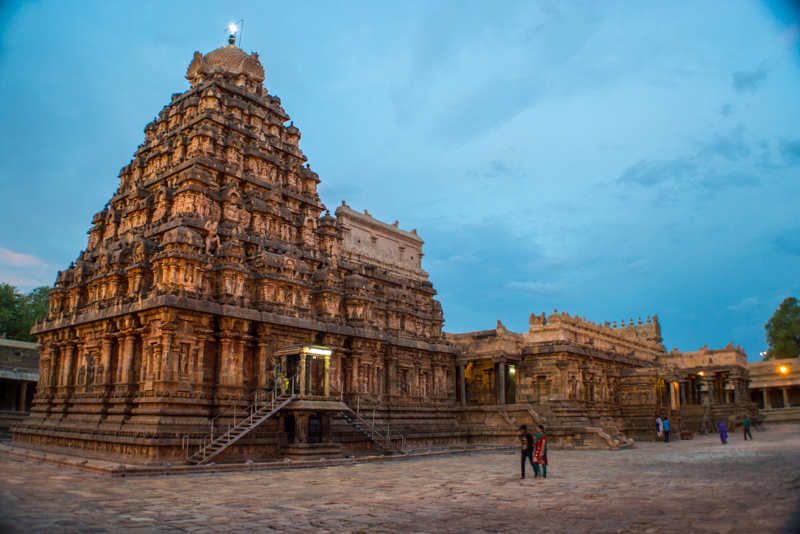
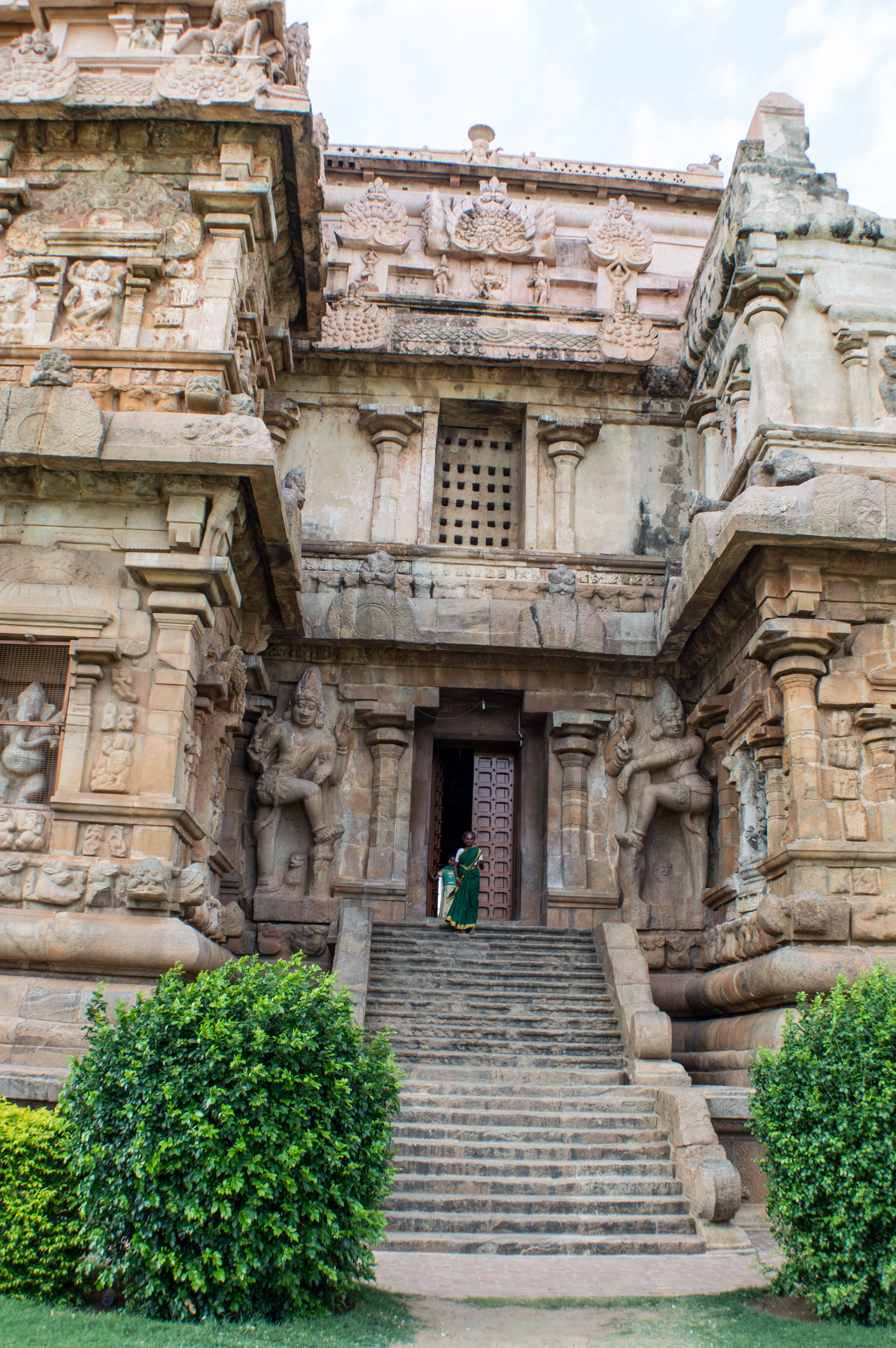
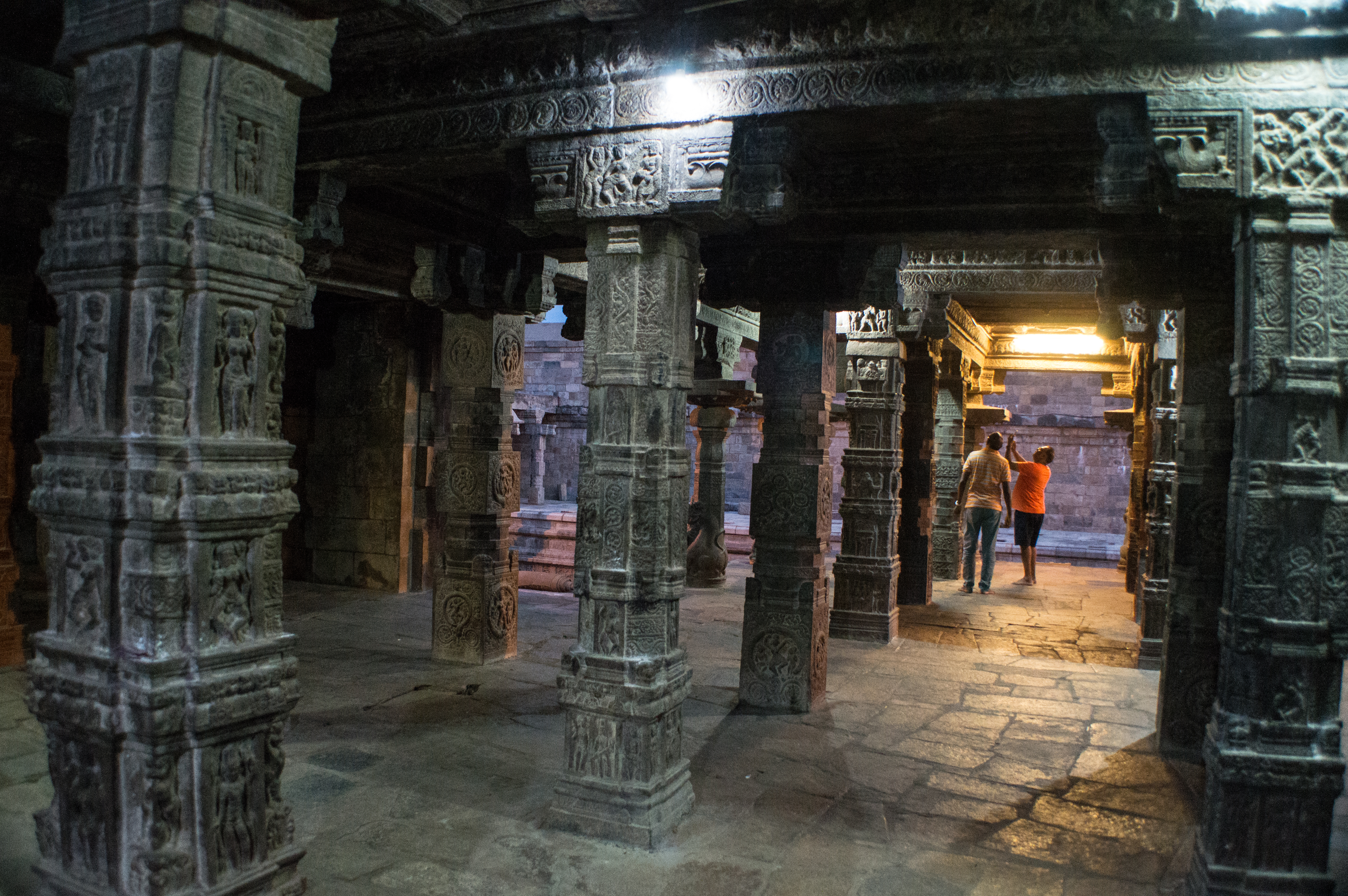
It seems that all the temple has a historical story for its construction. This one was built to celebrate the Chola king – Rajendra 1 (1012-1044) who brought the Ganga (river) to this place. The architecture, the ornately carved pillared pavilions and the magnificent vimana – the towering roof above the inner sanctum, is simply amazing. I was in awe how they planned and executed its construction. It must have demanded dedications and experienced craftsman. Above all, the architect whom had foresight to keep everything aligned and perfect! It is quite incredible that all this was accomplished over a thousand years ago.
After Gangaikonda Cholapuram, only a short distance we arrived at Darasunam – the beautiful dravidian Airavateswara Temple – built by Raja Raja Chola II in the 12th century. Another magnificent work by the Cholas. We went through a wonderful arch. I was fascinated and impressed by the design and structures. Hindu mythology carved in stone. Grand is to put it mildly.
Beside the Nandi statue, the “singing steps” – a small flight of stairs called the Balipeetham, gives out seven melodious notes! However, it is now caged for protection. Upon entering the intricately carved main gate, the Rajagopuram, I entered an enclosed area. I wandered the periphery to take in the great temple. A pillared outer corridor goes round the temple except on one side – a wall built with stone blocks. The carvings are intricate and the surfaces are adorned with many beautiful motifs and sculptures.

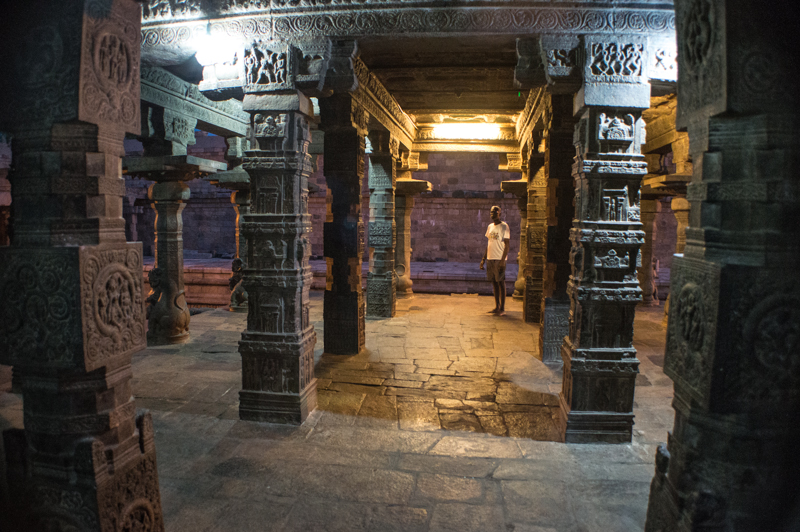
Light was fading fast. On the southern side, images of horses drawn chariots with wheels decorated the steps alongside elephants supporting a small pillared mandapam. The interior, black granite stones as pillars and ceilings. Like all temples, they are also intricately carved. A great place to sit, perhaps meditate or like me awed by the creations thousands of years ago. Certainly bewildered how it was constructed. Then in awe of its magnificence. Furthermore, this temple is not a museum piece but functional temple – a living museum piece indeed.
Something about these temples brought calm. A sense of purpose and fulfilment came upon me. Perhaps, the ambience of the evening or very few mortals roamed around me. Time was not rushed (many temple in India are crowded and throngs of people queued to get in). Such was not the case here. I read somewhere that this unique design represented nitya-vinoda – “perpetual entertainment of the mind”. Perhaps, that’s what it is!
7/8 – Thanjavur
Thanjavur, on the banks of Cauvery River, is a significant city – the ancient capital of the Cholas. The empire, after defeating the Pallavas, began in the 9th century and ended when they were defeated by the Pandyas somewhere in the 13th century. The Chola Empire is the longest ruling dynasties in Southern India. It was a period where arts, religion, literature and culture flourished – the beginning of the Sangam Period. They are also the only dynasty to expand their empire outside India – South East Asia (including parts of Malaya, Indonesia, Cambodia and Vietnam. The so called Indianised Kingdoms. Their legacy left behind in ancient Malaya like in Kedah and Melaka. History suggest that they were not aggressive conquerors but mainly through religion extension and trade.

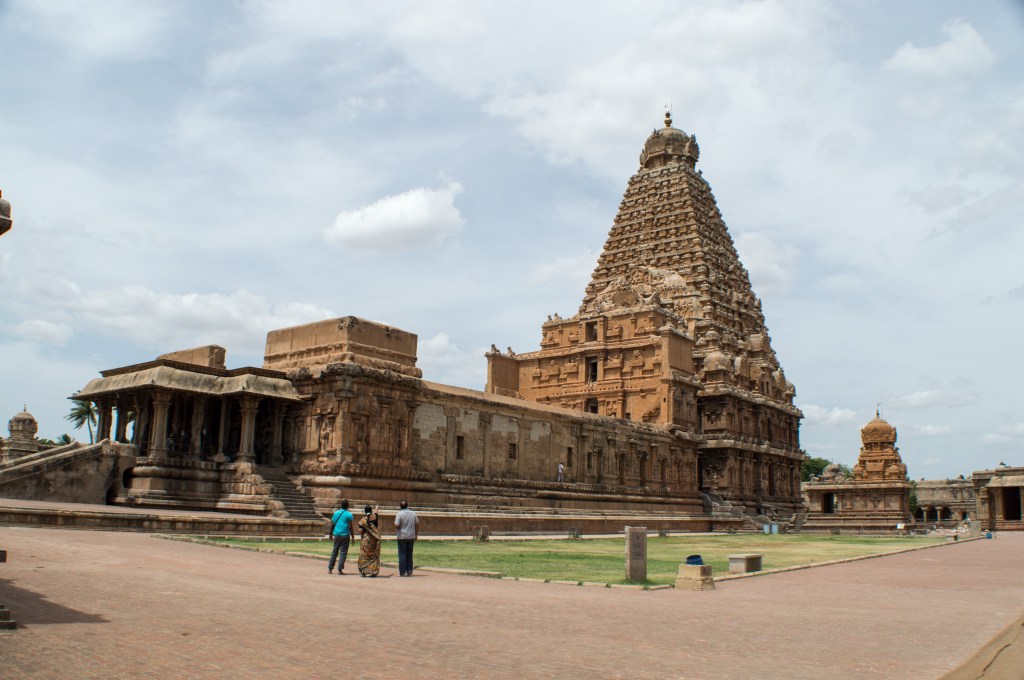
The most significant temple built in the 11th century is the magnificent Brihadeshwara Temple or colloquially called Big Temple. It was built by the great Raja Raja 1. Built from granite, it had stood here for over 1000 years (including withstanding numerous earthquakes). My first sight was, as we drove over the Cauvery River, the tall Vimana (tower). We entered through a giant gateway (gopuram) – Keralathankan, decorated with numerous sculptures. Workers were doing some repairs. The outer wall encircled the complex. We then entered another gopuram – Raja Rajan Thiruvasal, and equally decorated with structures – representative of the Hindu Pantheons. However, the entrance is protected by huge sculptures on either side. The outer wall is adorned with numerous carvings. In front is a kneeling Nandi under an elevated pavilion. Only now, I began to realise the magnitude of the majestic vimana. It is 63 meters tall. To crown the top, a Kumbham at 80 tons was placed! How was it possible to construct with a hard material like granite and carry all that weight to the top? It is truly an architectural marvel. The Chola king wanted it to be really grand, being the capital.
A corridor with numerous smaller shrines encircled the inner compound. Metal rails prohibited entry. It was a hot day. On one corridor, a small museum-like, explained the construction and important structures of the temple. This is a Shiva temple. Murals of all sorts decorate the interior walls. They are beautiful. Wonder if they were the original paintings. If yes, we are gifted to have witnessed creativity and masterpieces of over a thousand years ago. The current temple with several smaller ‘side temples’ are additions after the Cholas. Following rulers – Pandaya, Nayak and Maratha periods, of Thanjavur had added structures. Hence, elevating the temple complex as one of the important temples.
There was quite a bit of repair works being carried out especially around the back of the vimana. Rows of tiles were arranged on the floor. It is hard working in the hot sun and the heat generated by the stone floors.
Walking around, I noticed some inscription etched onto stones walls and beneath structures. I believe it is Sanskrit (with Tamil alphabets). Another interesting find was the 81 Narakis or dancers carved on the walls representing the various poses of the Bharata Natayam. A chart in the ‘museum’ didplayed the various poses.
It is sad that I was not able to understand the narratives of the structures, motifs and murals that filled this complex. All the stories carved in granite. All I know is, it is absolutely amazing and beautiful. Take religion out, anyone will find it’s historical, architectural and craftsmanship of all these temples, created a thousand years ago, amazing. History is very tangible here.
Are we tore away from the magical Big Temple of Thanjavur, we headed back on a rather busy street. News of the bed stricken Karunanidhi was unchanged. Balram was still edgy. On a street, a huge poster of the man was pasted on a wall. Further along, we came across devotees carrying kavadi (to pay penance) on the road headed to a nearby temple . Prayers are to Murugan, son of Shiva and Parvati. Their bodies pierced with metal hooks on the chests and backs. A long metal rod pierced through their cheeks. Strangely, no bleeding occurred. That’s the spiritual aspect of this tradition. In Malaysia, it is called Thaipusam, usually held in February.
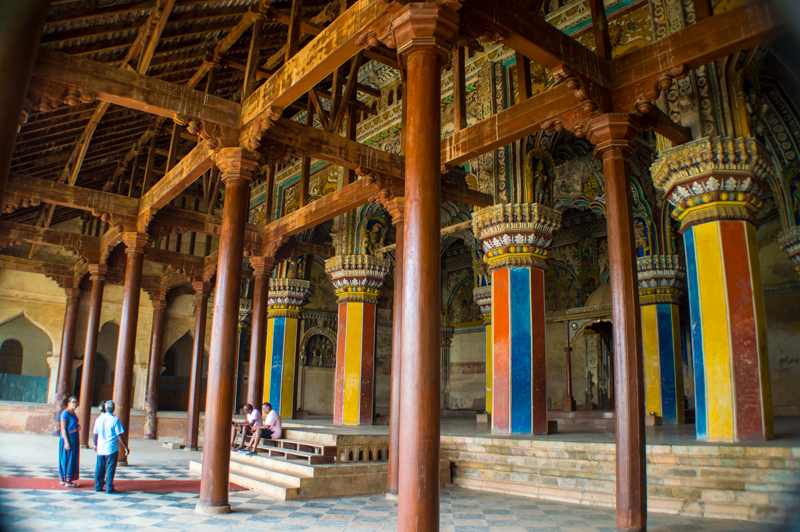
We continued our discovery of Thanjavur to Maratha Palace Tanjore or Thanjavur Palace. The names seem interchangeable. It was built during the Nayak period and later additions by the Marathas whom ruled from 1674 to 1855.We purchased our all-inclusive tickets and headed to the Sarasvati Mahal Library. The courtyard was colourfully decorated. However, we were not allowed to enter the library. Scholars only. Well, here are kept collections of ancient scripts written in Tamil, Sanskrit, Telugu and so on. We moved on the Art Gallery. There were collections of art works, old weapons and statutes. A courtyard opened revealing the Arsenal Tower and the Bell Tower. It is quite an interesting place with passageway leading to ornate buildings. The rectangular seven story Bell Tower is quite unique. The Arsenal tower or Gooda Gopuram was constructed in 1855 CE. It was used as a watch tower and a weaponry.
A small stall sold souvenir items including the famous Thanjavur dancing dolls and whistle. My brothers amused themselves with yhe shop keeper. Typical!
8/8 – Madurai
From Thanjavur to Madurai, the motorway was almost empty. This is the fear that a riot may start with the impending death of Karunanidhi. Small vigilante groups patrolled the roads with no interference from authorities. Balram was attentive to the uncertain situation. We checked into our hotel and was advised by the staff to have our lunch here. It was a fabulous lunch. My brothers decided to have a siesta. Not me. The hotel staff again advised me not to travel yet as they were concerned about my safety. I reassured them, hailed an auto and headed straight to Madurai Meenakshi Temple. Dusk was creeping in.
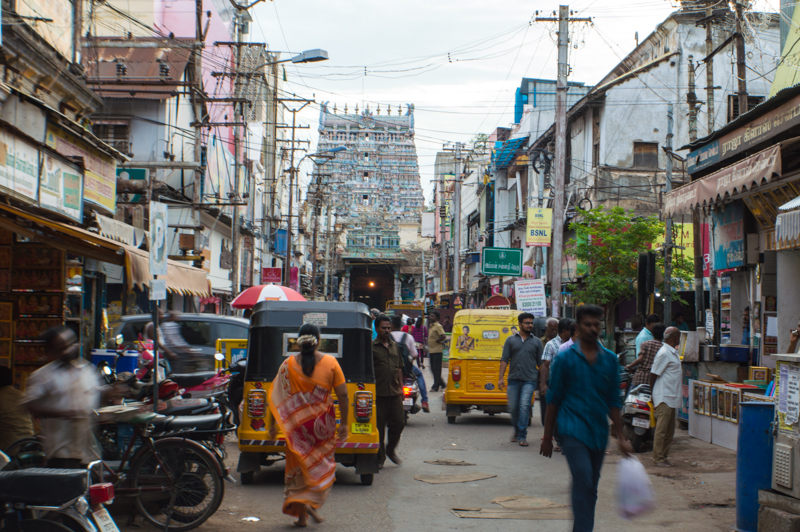


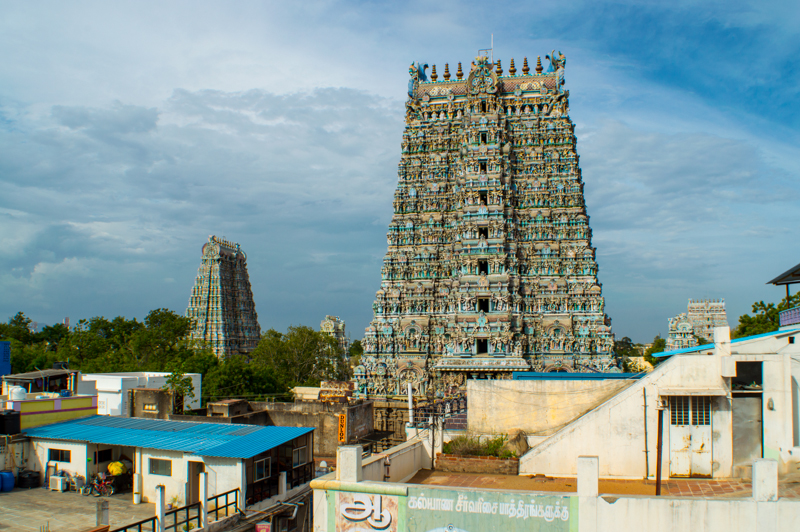
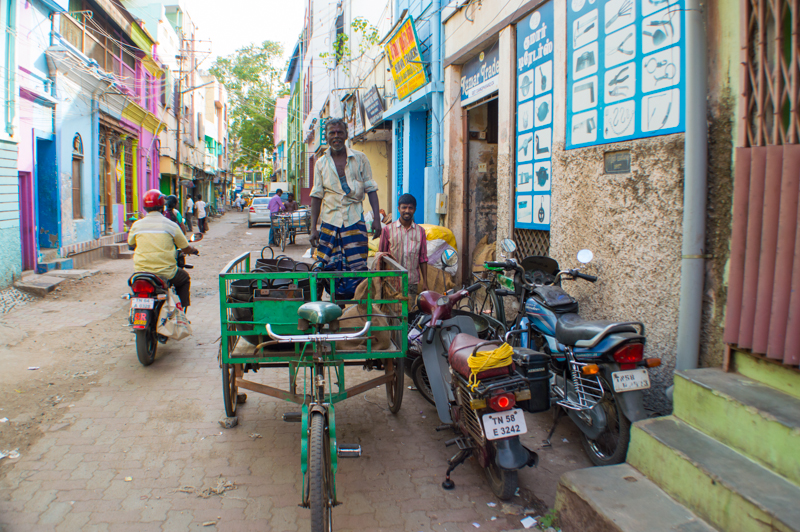
One of the highlights of travelling in Tamil Nadu is its majestic ancient temples. Some are more revered that others. One such temple is the 1600 years old Madurai Meenakshi Temple. The main shrine is Meenakshi, an avatar of Parvati – consort of Shiva. It is a leafy area and the temple is enclosed by walls. I approached the temple through a shopping hall “puthu mandapam”. Its towers soar into the cloudy sky. Some over fifteen stories high. There are fourteen “gopuras” in this temple complex. All carved with myriad of gods, goddesses and animals. It is totally enclosed with high walls and towers at four cardinal points. It was crowded, and that is expected. However, tight security was highly visible. All bags, camera and cell phones were prohibited but stored away.
9/8 – Madurai
Temple guides and touts hang around here too. However, they seem to take no for an answer. Very contrasting compared to Indians in the North. I entered through the East Tower Gopuram. Although crowded, once inside, there seem to be an unwritten order, and everyone just got on with what they want to do. I just moved from shrine to shrine and ended in a different place constantly. Eventually I entered the inner sanctum, had my prayer done. There are many sanctuaries and sections. Where do I go? Suddenly I exited into the Thousand Pillar Hall. It is quite mesmerising! I would not know that in early February, a fire gutted part of this “mandapam” – hall.
The experience was overwhelming and sat for a moment to gather my thoughts. I tried to perform worship and be a tourist at the same time. There was a sense of being here and then nowhere. The beauty of the carvings, Hindu motifs and the very arrangement of the various halls and structures is truly a wonder. This is a Dravidian temple with typical characteristics – pillared halls, tall gopurams – towers, two or more entrances, water tanks for ritual bathing and covered porches. Not only were the pillars carved, the ceilings were brightly painted in spherical shapes. I exited the complex through a maze of structures and people. The periphery of the temple complex is occupied by mostly tradesman accommodating the devotees and tourist. Shops sold sarees, prayers (puja) items, offerings including flower garlands, wedding accessories and so on.
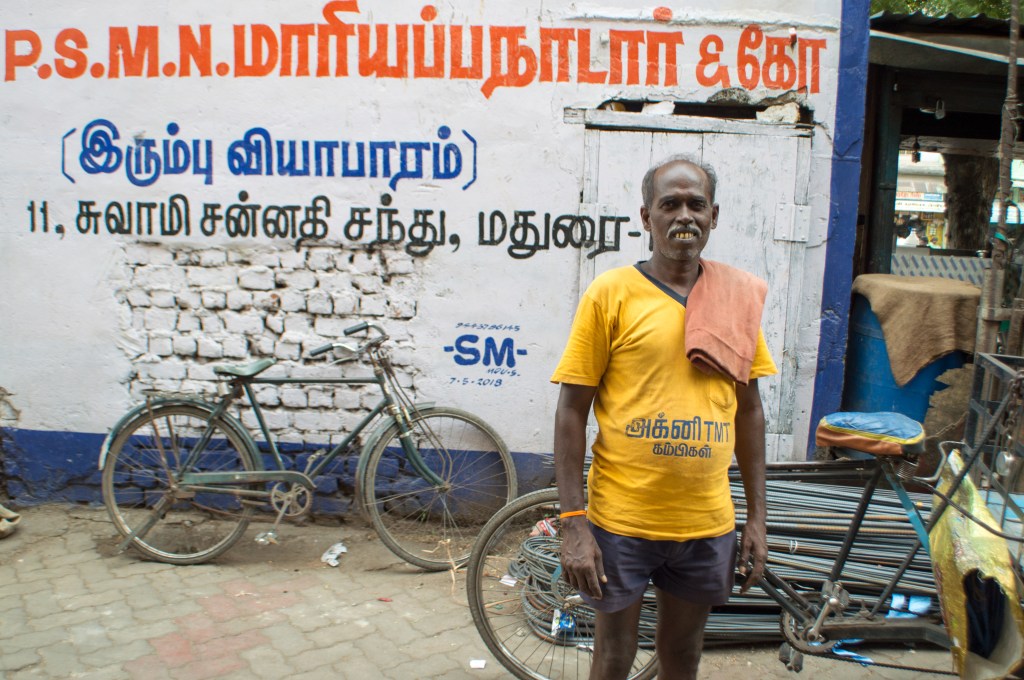
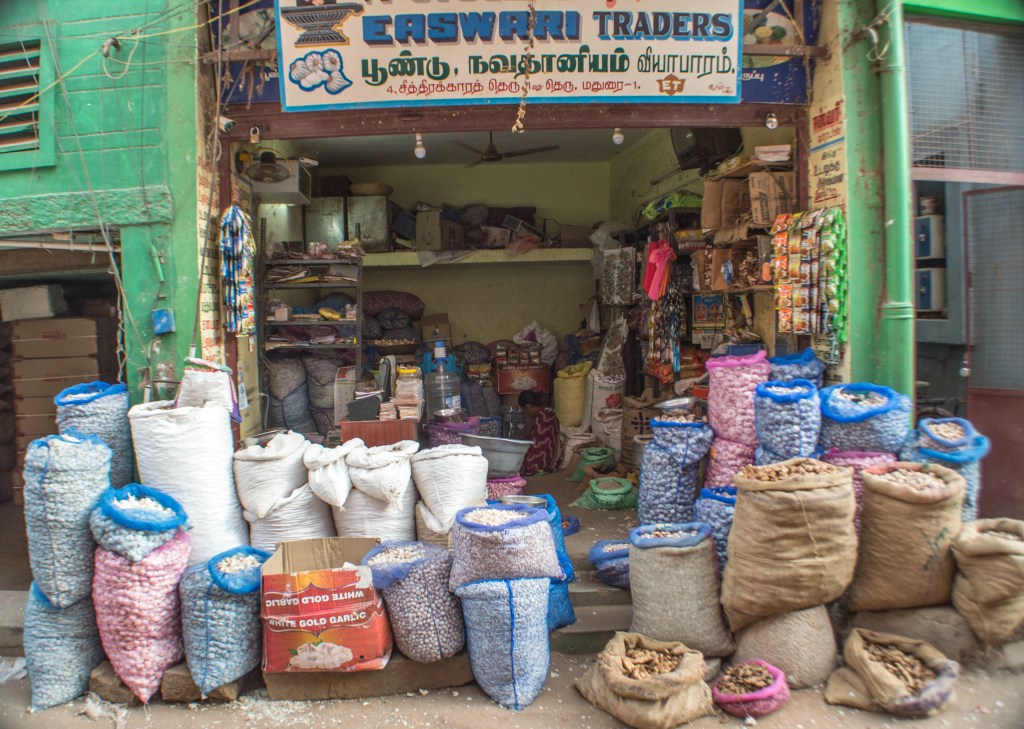
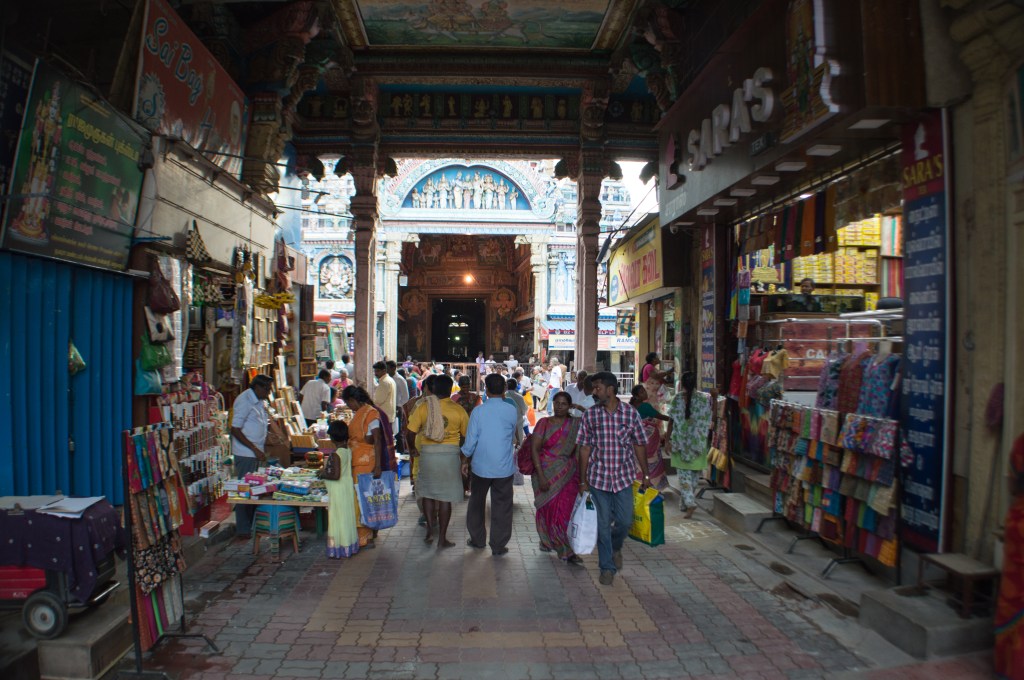
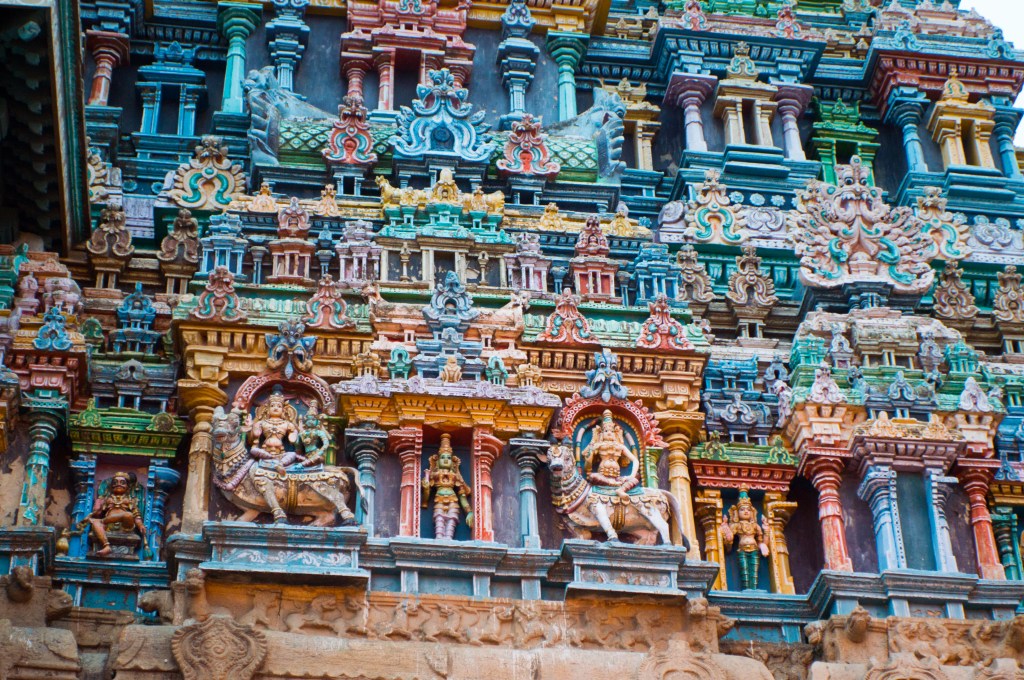
Coming to a temple is not just for prayers but a complete package of items to buy, use or to take home. It is an outing – worship, shopping and celebration. Walking away from the complex, main streets led to smaller streets and back alleys. I love to explore these places especially markets and bazaars. I heard there are some wholesale markets including the banana and onion markets nearby. I was on the hunt. I found them. However, the journey to get there was an interesting way to see new things.
Like all in cites, it is busy, noisy and crowded. Sound Horn is a common signage on lorries. I found the wholesale area. It was filled with wherehouse and trading shops – onions, metal works, spices and so on. Workers peddled their tricycle hard to get the goods moving. Some, exhausted from work in the late afternoon heat, rested wherever they can. However, what was interesting and very humbling was they all made time and effort to stop and chat with me. They were intrigued with me – a Tamil speaking foreigner. At the onion market, a seller was saddened that his rented 120-year shop would be demolished in twenty days and replaced with a modern multi-storied building. Meenakshi Temple is omnipresent – in fact, it is the axis-mundi of Madurai.
Later in the day, news was out that Karunanidhi had passed away. Then, a new drama unfolded, the burial site was disputed, and the courts were opened at 10pm to conclude the matter. Fortunately, the government gave in to the demand that his body is buried at Marina Beach, the site of past Chief Ministers.
9/8 – Palani
From Madurai, we made a day trip to Palani – to visit the Murugan Temple. It is a two-hour drive there. Balram, our driver, advised us about the touts and just go by ourselves. This is a hill-top temple. There are a few ways to get to the top – take the rope-way or walk up the steep concrete steps. There is a third way – the elephant path. These steps are less taxing but a little longer. We took it.
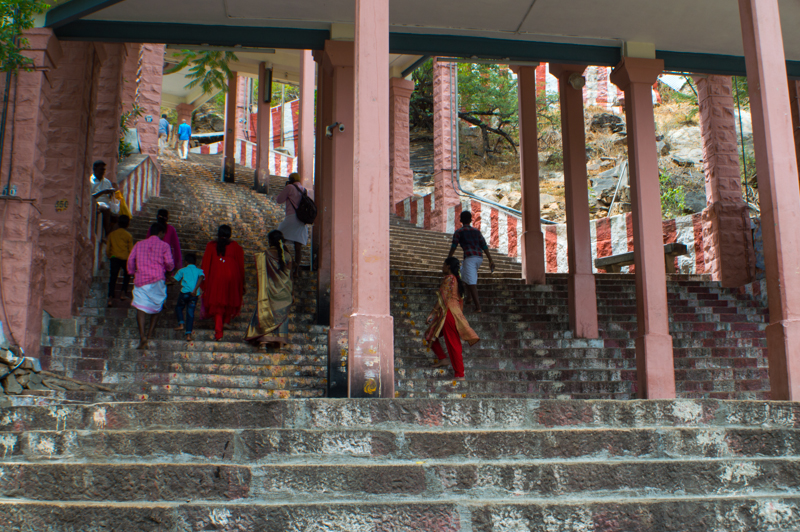
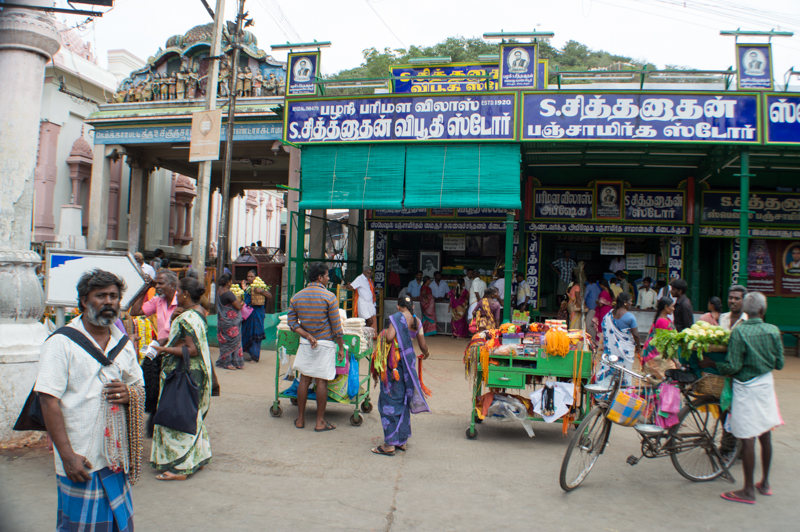

There is something poignant about climbing a hill or mountain to get to a place of worship. This answer came to me when climbing to Dubdi Monastry in Sikkim. Its symbolic – with each step, I bow down, sort of paying penance before reaching the top for salvation. Hopefully!
Tickets must be purchased. Not that simple – normal, fast track or super-fast? We purchased the fast track. Later we realised that it was not crowded. We proceeded to the gate through a narrow railing (for crowd control). We were the only ones. However, it was locked – no entry. Monkeys kept us company. We asked around and was told that if we purchase another ticket, we could go into the inner sanctum where prayer was going to be conducted. So, we bought another ticket. However, the staff would not refund the earlier purchase. We left and completed our prayers. Crowds of people were already queuing outside. We handed our unused ticket to a family. Is this a scam or ignorance on our part?
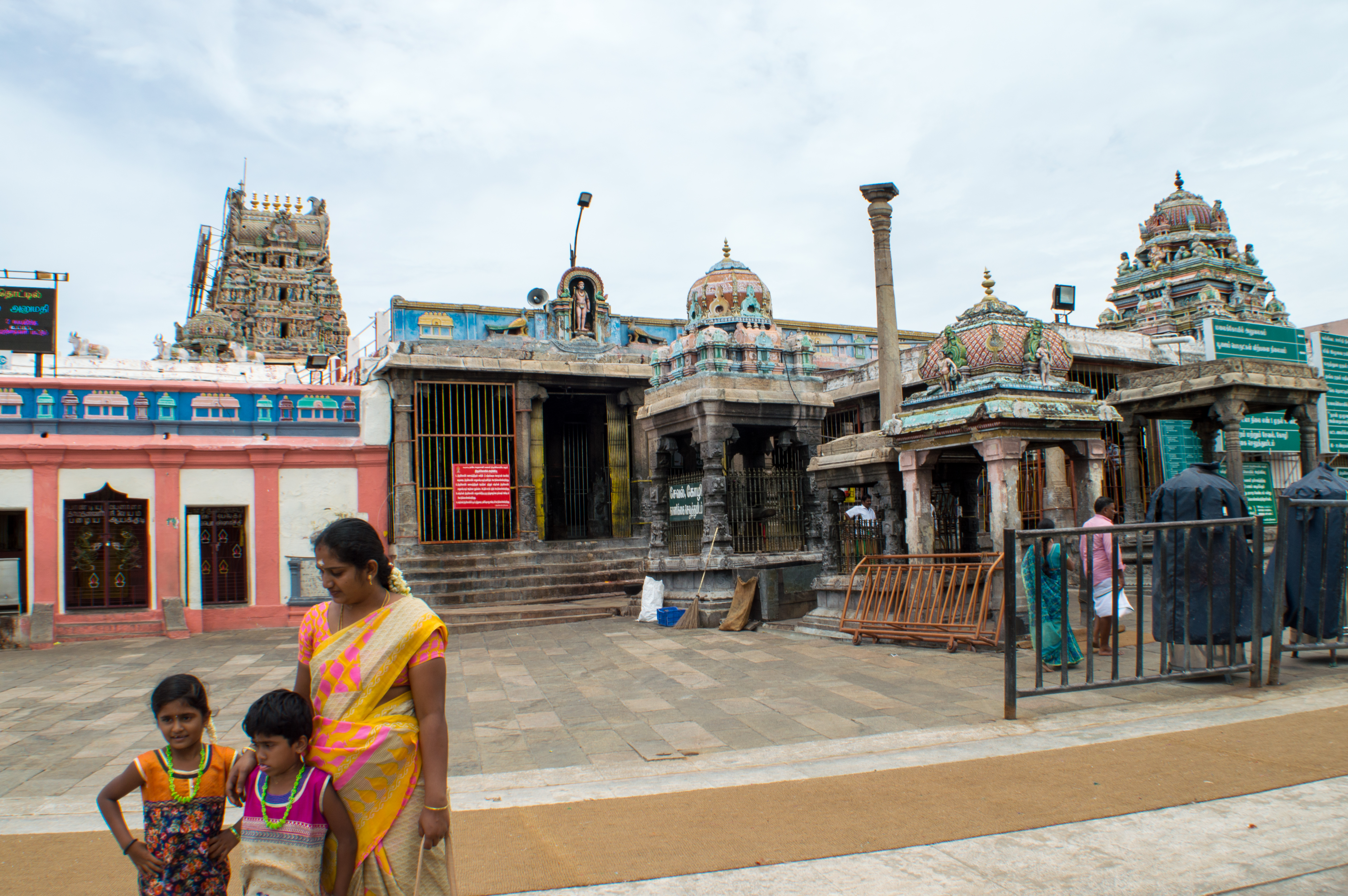
Lunch at a local restaurant. Something caught my eye – betel leave wrapped with a reddish sweet stuff. This is Indian paan. The traditional one in Malaysia used betel leaf, cracked betel nut and slaked lime. In India, there are numerous – sweet and savoury. One chews them and later spits the reddish liquid built up in the mouth. This explains how some streets and walls are splashed with red ‘paint’.
My brothers will head off to Chennai and from here-on, I make my own journey through Tamil Nadu. No more up-market hotels. I must add that our first experience travelling together had been fun and most of the time hilarious. I loved it.
10/8 – Kodaikanal
Form Madurai’s Arupalayam Station, I caught a local bus to Kodaikanal. The later part of the journey is winding as the road climbed uphill. Coming from the plains, the coolness is immediately felt. We have entered one of the diverse parts of India in terms of flora and fauna – the Western Ghats. It is a mountain range that stretched from Mumbai (north-west to south- west) towards Kerala. A small section protrudes into Tamil Nadu at Kodaikanal (2100m).
It was raining when I arrived at a noisy bus station at midday. My accommodation was located at the end of a walkway – Croaker Walk. It poured with rain and the views obscured. After waiting for a while, as if like magic, the clouds parted and revealed the hills and valleys. There were views towards Palani Hills. Croaker Walk is literally on the edge of the world. With the rain earlier, it created a dreamy landscape. It was invigorating and pleasant.
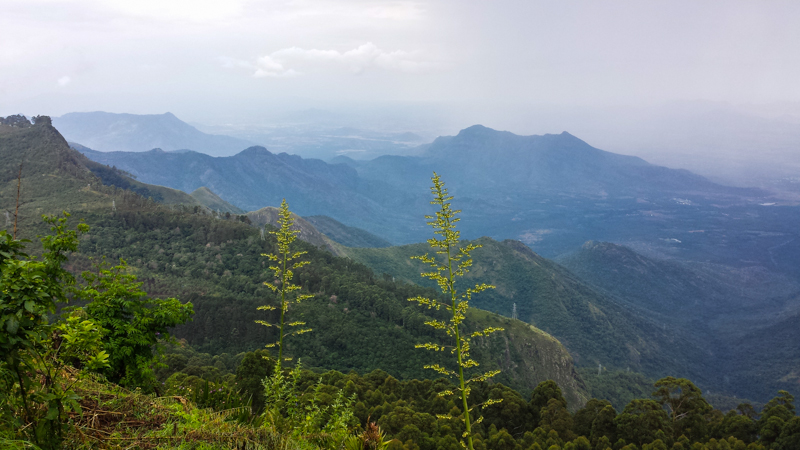
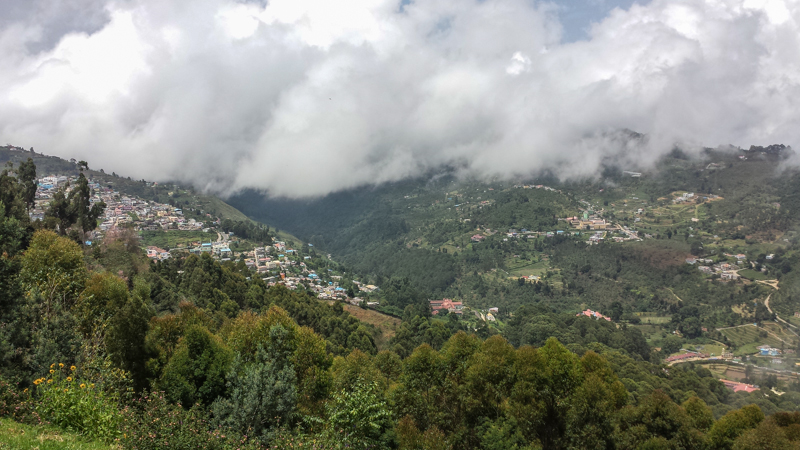

This hill station is very compact and is great to travel everywhere on foot. However, for the same reason, it is crowded, noisy and quite untidy after a rain. There was nothing to do. Perhaps, I should have gone towards Pollachi – Annamalai Tiger Reserve. However, the logistics were tight and uncertain about road and lodge closure due to recent heavy rains and flooding.
Lately, this area and those in the Western Ghats had been getting a lot of rain. I heard of flooding and road closures. Fortunately, I bumped into Sekar, a local trekking guide. I joined three other tourists for a tour and trekking for the next day. My stay at the hostel was horrible – noisy Indians with disregard for others. I was not pleased.
With the uncertainty of the rain, I decided to head out towards Vattakal Waterfalls. It is a decent walk through the forest. In the cool weather, it was pleasant and refreshing indeed.
11/8 – Kodaikanal – Poomberai Village trek
Early next morning, Sekar was already waiting to pick me up for our tour and trekking. I had no idea where we were going. I did not care as I just wanted to get out of town and walk. He was quite excited that I was able to talk to him in Tamil. By the way, my cost for today’s tour is reduced by virtue of my ethnic origin. As we chatted, we arrived in town with views of Byrant Lake and the surrounding hills.

Sekar explained that with all the recent heavy rains, his normal trek from Kodaikanal to Munnar is cancelled. Many area have been inundated with landslides too. The main roads too have been closed including access to Munnar.
The scenic journey was mainly rural subsistence farming and pine forest. We stopped at a restaurant. The view of Poombarai Village was stupendous – their picturesque multi-coloured houses amidst lime green terraced fields. Poombarai (1920m) is located 18km from Kodaikanal in the Palani Hills. Poombarai is well known for its mountain garlic production. Most of the farming here is subsistence.
We arrived at the village centre – a small square with a temple. There were a few shops and warehouses. Some villagers were preparing to go into their fields with tools over their heads and shoulders. We descended into the fields – cultivated with garlic, carrots, cabbages and others. We met farmers tending to their fields. The surrounding hill were covered with passing mist. The weather at 1900 m was cool and the soil seemed fertile. Ideal for vegetable cultivation. When the wind blows, the lush foliage of the garlic fields swerved like waves. At times, our track was just a narrow earth path between the plots. Water was brought into the plots via a series of soil cut channels.
People, although busy are friendly and spared time to chat. While weaving and winding around the cultivated fields, we came across a man with two bulls. Their horns were especially menacing. During the latter part of the trek, Sekar encountered a black cobra running across the field. We returned to the village centre. At a collection centre, bails of garlic were loaded onto a lorry for transport to the big cities. Near the Murugan Temple, a sundry shop was busy with customers.
We returned to the viewpoint restaurant for a cup of sweet chai. After a long walk, a hot cup of chai felt good. A local man was selling of the garlic from the village. He claimed that Poomberai’s garlic is the best in India. It had a strong pungent odour. An indication of its potent medicinal properties. The villagers call this “malai poondu” or mountain garlic.
We reluctantly left picturesque Poombarai and headed off to Moir Point. From here, there were expansive views of the peaks and mountains surrounding Kodaikanal. Sekar then took us to another viewpoint – Pillar Rock. These are vertical granite pillar rising from a lush forest. The mist had just lifted and expose these beautiful coloured rocks. Watching the mist moving in and out of the pillars was exhilarating. The Devil’s Kitchen lies between us and the rock. A deep cleft that resembled a witch’s cauldron with mist swirling around. Nature showing off its beauty.
A short drive later, we walked into the forest not expecting much. The trail led to a few trees with a network of exposed roots. They were all entwined. The surface soil had eroded exposing and eventually hardening up the roots. It was extremely artistic but natural. I am glad I bumped into Sekar. It was a good day out. Unfortunately, my hostel room was disappointingly crowded with noisy Indians. I left and ended in new hotel in town. A little luxury with towels, shower and breakfast! Kodaikanal is a place for exploration in a serene and natural environment.
12/8 – Coimbatore
My plan today was to get to Metupallayam. However, the bus journey was too long and decided to break in Coimbatore. First a bus from Kodakanal to Pallani. Then transfer to Coimbatore. The bus journey out of Kodaikanal was exciting as the roads wind around the mountain slopes with wonderful views of the valleys. It can be dangerous too as, like everywhere in India, speed and traffic rule is decided by the vehicle – the bigger you are, you have the right of way! Looking at our driver, I believed we were in good hands. At midday, the bus stopped at a tea stall. The view of Palani and the valley was stunning. The sweet Indian tea was great too. I arrived Coimbatore in the evening.

As usual, chucked my bags and explored. The streets were packed with small business and shoppers. It was buzzing with activity including sweet shops – my weakness. Nearby was the town bus station. Eventually, I discovered neon-lit Cross Cut Road. This is the main shopping street with all the major malls and eateries. It was packed with cars, auto, motorbikes and pedestrians. Motorbikes meant for two now accommodated four and sometimes five people. Street vendors in three-wheel carts darted in-between pushing their wares. On the sidewalks, impromptu stalls sold from food, flowers to sundry goods. Dinner was at the popular Annapoorna Sree Gowrishankar. Fantastic vegetarian meals and great coffee. Across the street, a familiar name – Pothys, a shopping mall with all things Indian.
13/8 – Coimbatore
This morning, I headed straight to Gowrishanker Restaurant. Coimbatore is sometimes referred as Manchester of India for its manufactured products including textiles, household utensils, plumbing, machinery, pumps, constructions materials, etc. They are generally referred as ‘marakadai’. The auto driver remarked that most of the business here are controlled by Muslims.
There is the poorer side in every city and Coimbatore is no different. The auto here seems to be new and glossy. Later, I ventured to the ‘poo’ – flower market in RS Puram. I love this place. Why? The assault of the different scents, the riot of colours, the animated characters of traders, merchants, the sweaty hard – working workers transporting the produce and the hard-bargaining buyers. The best deals for buyers are early morning when it is cool. The intoxicating fragrance permeated through the air. As the day breaks, the heat through the roofs makes life difficult as the heaps of flowers begin to fade and wither. Regular misting is sometimes required.

Carnations, jasmine, lotus, oleander, roses, marigold are amongst the flower on sale here. Beside loose flowers, there is an army of worker stringing-up garland for functions and temple ceremonies. I met a group of jovial women doing this. A banana fibre is used as a string and the arrangements begin with selection of flowers and colours as per order. With deft hands (after years of experience), garlands are made in a multitude of design, colours and sizes. Nearby were the vegetable and fruits vendors.
The people here did not mind their pictures taken. However, be aware that it is a business centre. Push carts and workers laden with flowers on their heads and shoulders moved rapidly through the narrow lanes for deliveries and supply. The traders will quite happily chat while keeping one eye for customers. Communication is sometimes beyond words. Animated hand and facial expressions flew across the floor. Competition is fierce but all done in friendly jest. My problem was what and which pictures to take. Sight, sound and smell is all challenged here. It was great for me to talk to some of them in their mother-tongue – Tamil. I loved the vibrant and spirited manner this flower market exhibited. It also revealed the true character of the South Indians – friendly, approachable and inquisitive. That was refreshing as all previous experiences in Tamil Nadu had been similar. Quite the contrary from the North Indians! Only one thing on their minds – how much money they can make from me!
13/8 – Mettupalayam
The only reason to go to Mettupalayam is to ride the famous Nilgiri Toy Train. Local buses from Coimbatore Central Station left for Mettupalayam every 20 minutes. There is also a regular train option but means you need to get up around 5am and arrive at Mettupalayam to connect with the 7am toy train departure.


Mettupalayam is situated at the base of the Nilgiri Mountains. It was hot when I arrived in Mettupalayam and checked into Mayura Hotel. It looked like a frontier town where all roads seemed to meet – north, south, east and west. Numerous lorries laden with all kinds of products and materials busily whizzed past the main road. Advance booking for this popular toy-train is recommended. However, booking on-line was troublesome. There are two part of this journey – first to Coonoor and followed by another to Ooty. I managed to get a first class booking for the latter but only a waiting list to Coonoor. I was happy just to get a booking and sort it out later on arrival. Well, that was the plan. I was a little anxious. In town, I tasted one of the best mangosteens – sweet with juicy white flesh. There was nothing else to do but wander around the noisy and busy main roads. The hotel staff advised me to return early as the security after dark deteriorates. However, the people I met were helpful and friendly.
In the evening, I managed to speak to the Station Master. He welcomed me into his office and chatted away. He, like many Indians I had met, was amazed with a foreign Tamil speaking individual. He checked and my tickets were still on the waiting list. He suggested to book the open class as there were more seat available rather than the first class. He was very kind and advised me to come to the station very early around 5.30am. Secretly, I was hopeful my bookings will be confirmed.
Two men had meticulously prepared paan on the station bench. They were preparing for a very long journey to Calcutta. School children and adults crossed the tracks casually. Even the cows wandered onto the tracks. There is a wonderful Niligiri Mountain Railway Museum nearby.
14/8 – Mettupalayam to Coonoor (Nilgiri Toy train)
To ensure that I have the potential to get a seat (as mentioned by the Station Master), I was out of my hotel at 4.15am. It was dark and the back road to the station is unsafe. Determined to get there, I set off. I could hear a few low voices but kept going. Suddenly, I heard a squeaking noise. It became louder as I progressed. My heartbeat raised and steps quickened. Casually, as I turned, a cyclist rode past. I was relieved. I arrived safely at the station around 4.40am. There was no one. Even the lights at the station were off. I left my bag at the front of the queue. An hour later, few people arrived. The queue extended. The Station Master greeted me. Around 6.30am, I was given a note and boarded the train. “Sit on the left side, he uttered quietly”. Later, we were all told to get our ticket from the station counter. I will lose my seat! Anyway, I decided to check the name list of passengers on a wall. Surprisingly, my name was on it – First Class. Advanced booking is recommended. Otherwise, just turn up early and jump into the additional general class coach.
The Nilgiri Mountain Railway Company constructed the rail line from Mettupalayam to Coonoor between 1886 – 1899. The Indian government extended the track to Ooty in 1908. The full journey covered 46km. It rises from 325 meters at Mettupalayam to 2200 meters at Ooty. The journey to Coonoor will take about three hours. Previously, I had taken the toy train from New Jalpaiguri to Darjeeling.
I boarded the dark blue coach on the Nilgiri Toy Train. There was a man and a family of three. Unfortunately, there were only four narrow windows in each coach and seating for eight people. The general class in fact gives better viewing. There were four coaches (three general class (25Rs) and one first class (125Rs)). I was disappointed as there were no views for me. There was a lot of commotions as the black and blue steam locomotive prepared to depart. In fact, everyone whom turned up today managed to get a general class ticket. Once we pulled out of the station, the man informed me that he was disembarking shortly. At our first stop, Kallar Stn.(381m), I manged to get a window seat, finally. That made a lot of difference in the experience.
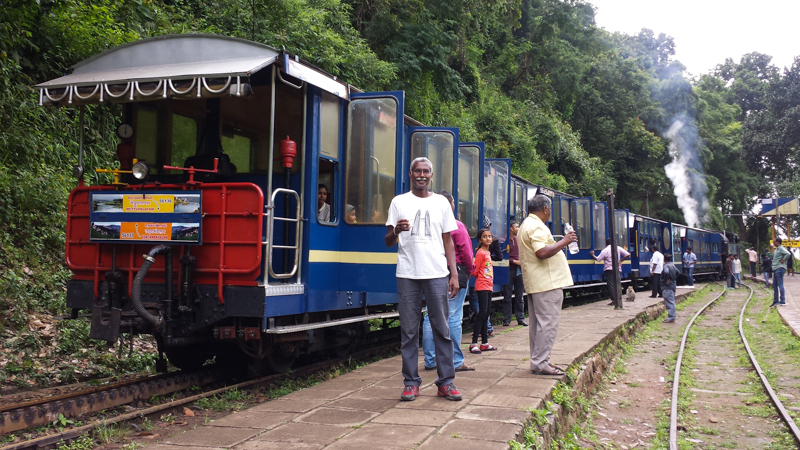
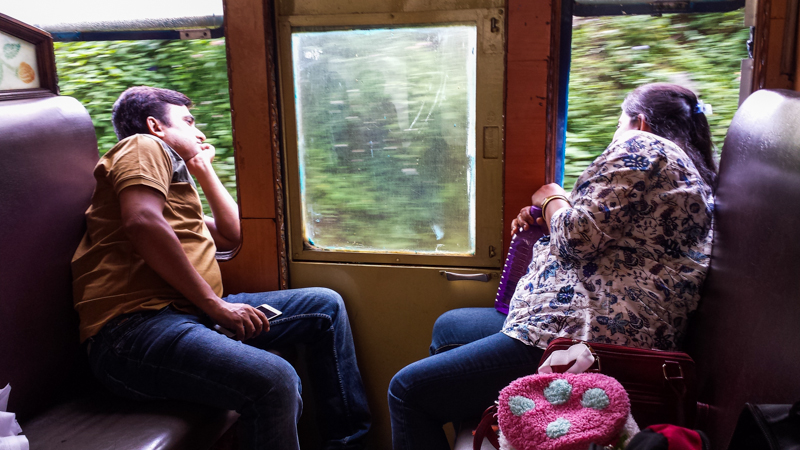

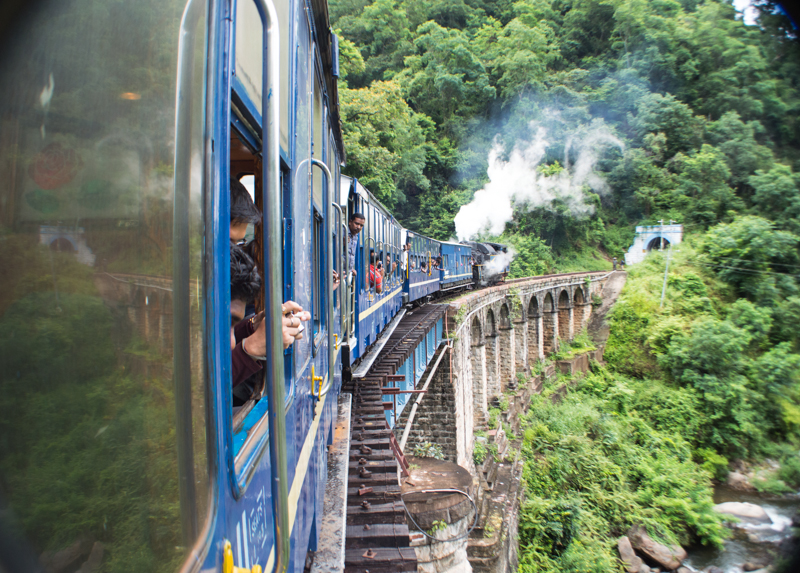
From Kallar station onward, the train engaged into the abt rack and pinion system. This provided enough support for the steam engine to climb the steep mountainous terrain. In fact, this line has the steepest gradient in India – 1: 12.5 gradient. A diesel engine would not suffice. Once settling in and looking out, I felt like a kid on a joy ride. It was nostalgic as I recalled my childhood train journeys. I loved it then and still love it now.
The sound of the iron wheels ‘click-clacking’ along the rusty track on wooden railway sleepers is a melodious sound. Soothing, as the rail coach swung from side to side. To be riding on this iconic classic toy train, is re-living history.
Looking out from this slow-moving train enabled me to soak in the beauty of nature and man-made wonders. The route passed through some picturesque landscapes including rocky terrain, pristine forested hills, narrow passages, tunnels, steep ravines, rivers and neatly cultivated terraced tea plantations. In the mountains, waterfalls dropped like silver ribbons into the valley. Beside the panoramic views, I was pleasantly surprised to see langurs, fast flying parrots and even wild elephants along the way. That was a bonus.
We arrived at Adderley Station (731m). Nearly everyone disembarked the train to enjoy the green surrounding. It is also necessary for the train engineers to refill the water tanks. This is done at every station to enable the engine to generate enough steam to power uphill. As with previous stations, each coach had a brakeman. Braking is not centralised, and everyone must be on the same page to execute the manoeuvre. With every departure from any station, these brakemen waved their green flags frantically to indicate that all is well in each coach. Only then will the engineer move forward. To get maximum power, the steam engine is at the back. Therefore, it is push motion. With modern trains, all this action are non-existent. Similarly, at the stations, staff waved green and red flags as signals. It is a shame – an art lost but still preserved in pockets such as this iconic Nilgiri Toy Train.
There are 16 tunnels and 250 bridges along this 46km route. Tunnels include rock-cut and others concrete. Similarly, bridges are made from wood and iron. At Hillgrove Station (1091m), it was time to get some hot tea and watch the engineers lubricate moving paets and refill water. It is also time for the brakeman to have breakfast and rest. Monkeys wait on the platform hoping to be fed. All aboard, and we are off. We streamed past Runnymede Station (1409m). Our final stop was at Kateri Station and onward to Coonoor. Neatly manicured tea plantation came into view. Finally, we rolled into Coonoor Station (1711m) around 10.30am. This is a highlight of my South Indian journey and possible one of the best train rides in the world. It was an emotional journey that took me back to my childhood days – heading from Ipoh to Kuala Kurau to see my dad, in the plantations, during school holidays. How is dad doing in Vellore?
Tip – the General Class coaches have better viewing opportunities than First Class. The reason – there are four narrow windows with 8 seats!
With the sound of the railroad still ringing in my ears, I left Coonoor Station by taxi to my lodge – YWCA Wyoming in Alwarpet. It is a great location as it is only short distance to the quieter and greener Upper Coonoor (near Bedford). The views of multi-coloured houses of Lower Coonoor was fascinating. Dwellings built on slopes gradually rose to the rim. Beyond that, the lush Nilgiri Mountains. It began to rain heavily. The staff kindly cooked lunch. I almost had this colonial house to myself. In the lounge, the fireplace was not going. Seated on a comfortable wicker chair, with a steaming cup of finest Nilgiri tea, I watched the rain fall over the tea bushes. Nowhere to go. It was blissfully soothing. The Nilgiri Mountains form part of the Western Ghats in western Tamil Nadu of Southern India. The highest peak is Doddabetta, at 2,637 metres. Coonoor, high above the southern plains, is one of the three stations in the Nilgiri Mountains. The other are Ooty and Kotagiri.
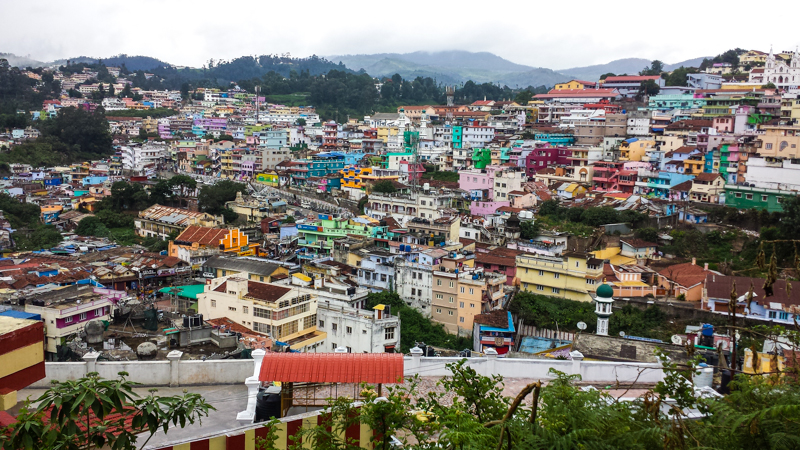
As the rain waned, I headed off to Bedford and onward to Sim’s Park in Upper Coonoor. Heavy mist descended upon the 12 hectares park with over 100 years of development. Views were obscured. The botanical collection from around the globe is impressive. It was exciting and very uplifting indeed to walk amongst these ancient specimens. Entertainingly, the local Indian tourists took their visits in stride – didn’t care about the rain and picture taking is a preoccupation. I admired their enthusiasm.
Later in the evening, I ventured into town. The walk from my lodge is great with colourful roof top views of downtown Lower Coonoor. It was busy, messy and noisy with traffic and pedestrians. Mount Road was filled with stores, shops and tasty treats. School children with maroon cardigan, long pants and chequered skirts chatted as the returned home.
Closer the bus station, is the town market. Although covered, it was dripping with rainwater in places. Despite the wet weather, business was bustling. Most of the vendors, like other parts of Tamil Nadu, are genuinely friendly and don’t mind having their photos taken. Courtesy counts, though. I invested in an umbrella to wander in this drizzly and wet weather. I headed to Hotel Lakshimi, across the bus station, for dinner. Delicious.
Back at the colonial YWCA, I managed to organise an auto transport for a day of excursion. It was organised by a staff – her cousin. It rained all afternoon and continued into the night. The caretaker offered me a hot cup of tea. I enjoyed the quietness and chill (and wet) of Coonoor.
15/8 – Coonoor
Mukesh, a clean-shaven young man, is my ‘tour guide’ and transport today (600Rs). The ride towards Dolphine’s Nose (10km) was very invigorating. It passed through mainly lush forest and terraced tea plantations. The weather was unpredictable. As such, viewpoints may not deliver any views. I took my chances and perhaps the ride itself would be enjoyable. We had wonderful views of the rolling manicured tea plantations as the mist moved around from the valleys. Patients is great as views come and go like the mist itself. Colourful plantation houses nestled amongst emerald green tea bushes looked like painting on a canvas. Occasionally, the clouds opened to revealed the plains below.
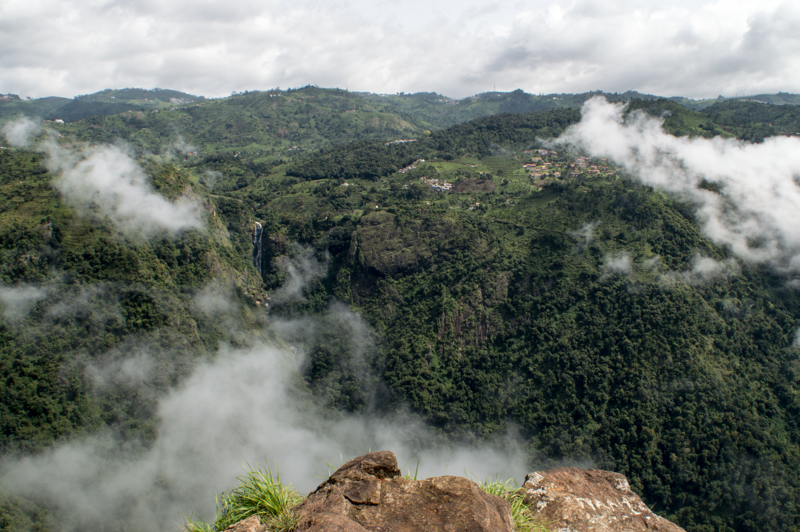
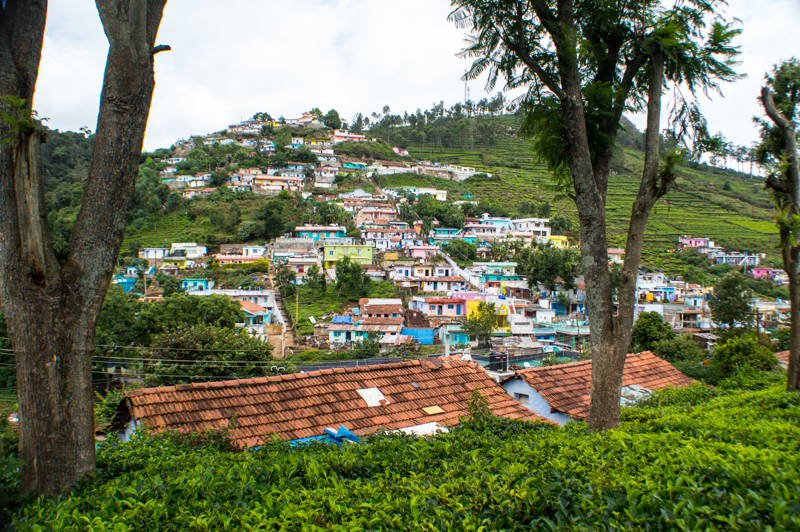
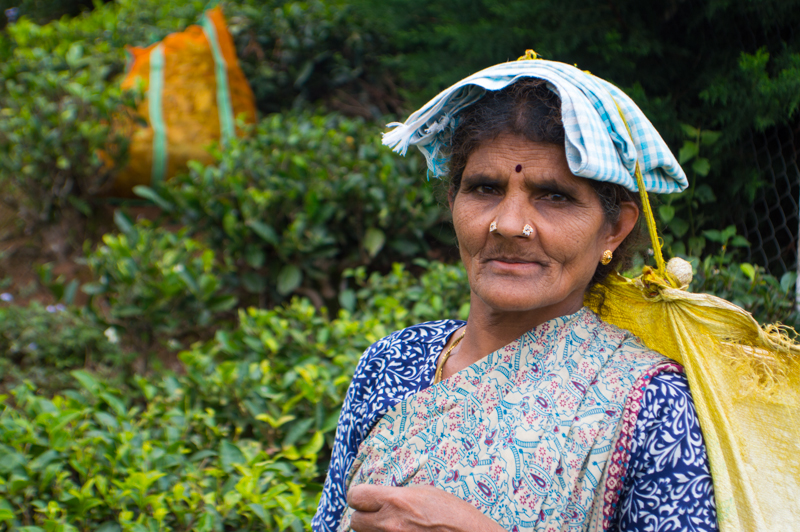

A short ride away is the popular Dolphin’s Nose viewpoint. It was a complete whitewash. The mist persistently hung around. Within minutes, the panoramic vista encompassing Catherine Fall and Kotagiri, another Nilgiri Hill Station, appeared for a brief but glorious moment. It was quite spellbinding. The wind was silent. Only the sound of the Catherine Fall. Within an instant, the whole vista was engulfed in mist. I waited for a while. Perhaps, it was just wishful for the mist to clear.
As we returned on the same winding road, we passed some plantation houses. We arrived at Karanchi Village. We stopped at Benchmark Tea Factory. It looked like it was in operation. Once inside the factory, the scent of leaf being lightly cooked perforated through the air. Picked tea leaf were laid over a large trough with hot and cold air passing through them. This is the withering process. Here, some moisture is removed. The ladies working there occasionally tossed the leaves. This process lasts for 12 hours. In one corner, another worker shovelled the semi-dried leaves into a hole on the wooden floor. I was curious. The leaves, once ready were swept into the hole to the lower floor through a vent for further processing. On the first floor, the leaves are further dried, shifted and packed into sacks for delivery. The factory manager invited me to try some of the tea – some blended with spices. Across the factory is the business end – sales. I bought a ginger and cardamom flavoured Coonoor tea.
The was something conspicuously missing during my travel around the tea plantations. Perhaps it a timing thing. No one was picking the tea leaves. Mukesh was not too sure either. I had no idea where we were going but I was confident that Mukesh did. As we were carefully managing a steep descent, I spotted a lady picking the tea bushes. I managed to have a short conversation with Pariamma. She has been picking in this plantation for about 30 years and lived in nearby Karanchi Village. She gets 16Rs. per 5 kg bag. It must be tough. No, she exclaimed. “I can fill up a bag in five minutes”.
Stop, stop I urged Mukesh. I spotted some animals amongst the tea bushes. Initially, I thought they were elephants. No, they were wild Gaur (Asian Bison). There are warning sign everywhere as these animals are temperamental. Interestingly, the Gaur does not damage the tea bushes. Instead, the feed of vegetation along the paths – organic weeding. I looked at Mukesh – “now, let’s find some elephants”. He was amused.
Our next stop was at another popular viewing spot. I had no expectation as the weather had been mixed with lots of mist. A narrow stone path led into a forested area. Roots of trees were exposed due to erosion. At the end of the trail is an exposed are and the edge walled off. The views were limited due to the weather. This area is nevertheless an important one – it is part of the Nilgiri Biosphere Reserve. A signage read – “the types of vegetation is indeed diverse ranges from evergreen tropical monsoon forest, semi-evergreen monsoon forest, montane shola grassland to moist deciduous, dry deciduous and scrub jungle”.
The Nilgiri Mountain is also home to several tribes including the Todas, Kotas, Chettis, Karumbas, Irulas and Panniyas. This is one of the areas where the ‘once in 12 years bloom’ plant survives – the Kurinji Flower (Strobilanthes kurthiana). I was lucky to see them bloom – blueish pink flowers, here (and in Kodaikanal). The flora and fauna are also unique here.
16/8 – Ooty
I boarded the 1045 Nilgiri Toy Train from Coonoor heading to Ooty dragged by a diesel engine. The journey is faster as the tracks are not particularly steep. Almost immediately after leaving the station, it began to rain. As such, it made looking out of the windows inconvenient. Compared to my first-class coach on the first leg, the windows in this coach allowed for a wider view. The journey mostly passed through wooded areas dominated by eucalyptus and pine trees. We passed Wellington station and as we passed Aravankadu, the were factories in derelict condition. I was fascinated by the small clusters of colourful homes nestled on the slopes of tea plantations and valleys.
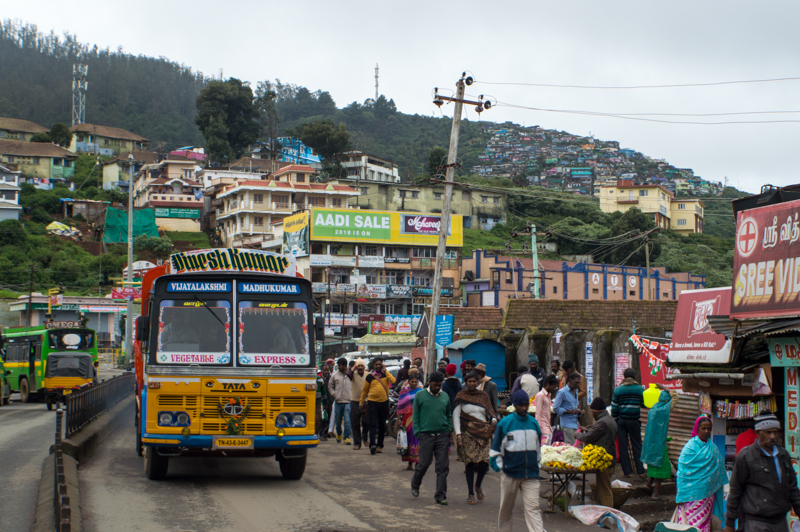

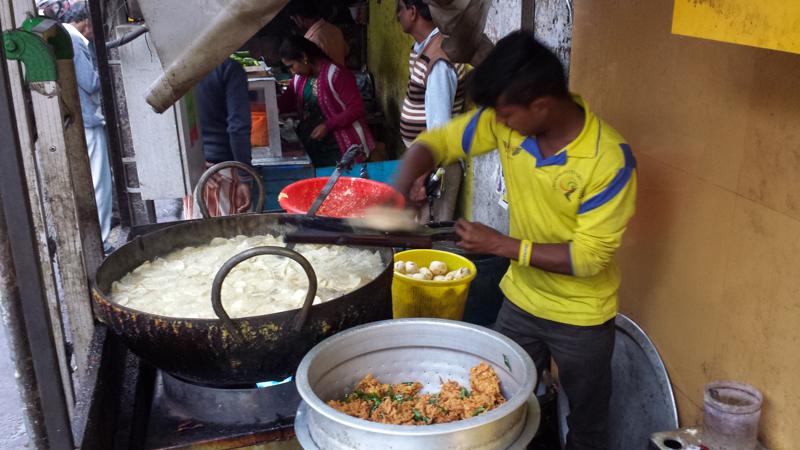
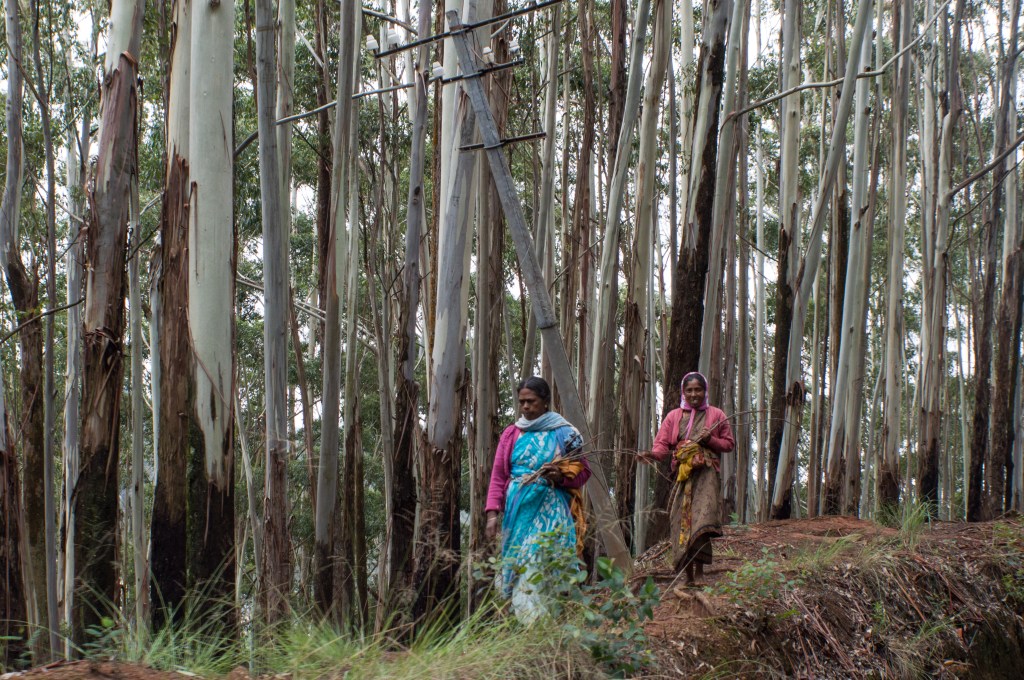
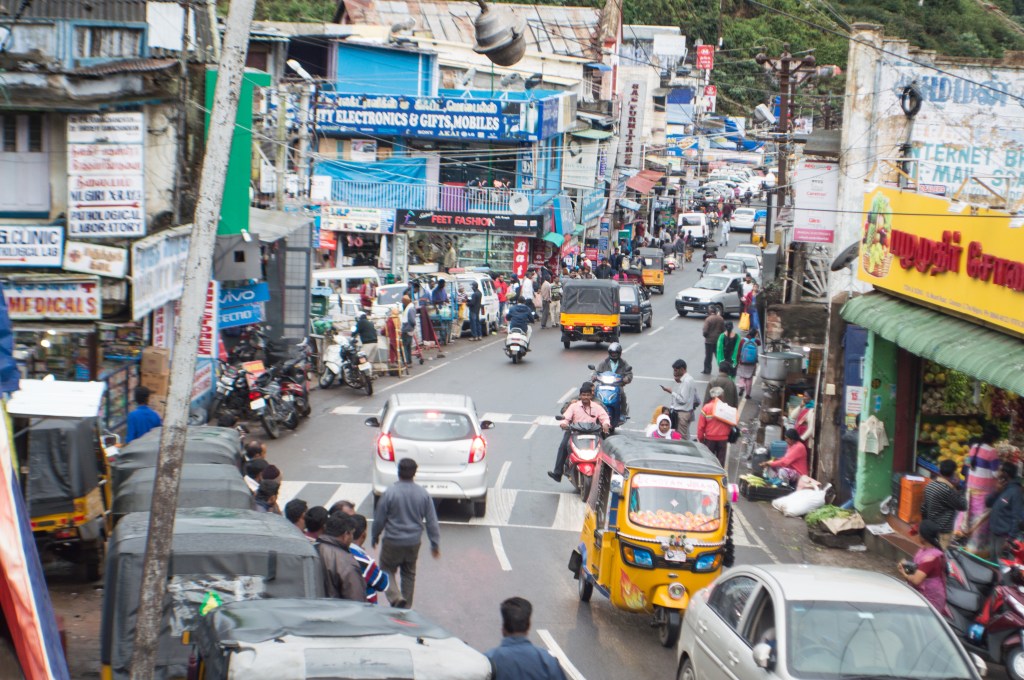
We arrived in Udagamandalam or simply called Ooty (2203m) around midday. It rained all the way to Ooty. The mist had already settled in town. The roads had turned into mini streams. This is the end of the wonderful 46km Nilgiri Toy Train. It has indeed been a nostalgic ride. With names like Lovedale, Fernhill, Runneymede and Adderley, you would too.
It was raining, humid and crowded on the streets of Ooty as I exited the train station. Checked into a hostel near the lake. The rooms were basic. With my umbrella in hand, I headed off to Commercial Road and had lunch at Junior Kuppuna, a restaurant chain. Later, some coffee in a proper cafe near the Botanical Garden. As with Coonoor’s Sim Park, Ooty Botanical Garden was drenched in rain and blanketed with thick mist. I was pleased to see the local Indians, without raincoats or umbrella, enjoying themselves. It was still a pleasant walk, although my shoes and socks were soaked. Comparatively, Sim’s Park had a better collection as an arboretum.
At my hostel, frequent power cuts were annoying. Hot water was not available, and internet was infrequent. I considered visiting some national parks namely Mudumalai and Nagarhole. Both are located en-route to Mysore. Unfortunately, with this continued wet weather, I had some doubts about the safari. Furthermore, several accommodations in the park and nearby areas including Wyanard had to close due to flooding. Even the Forestry Dept in Ooty was unable to assist. Even if I gone, the roads may become impassable and the views hampered. At 10pm, I canned that idea.
17/8 – Ooty
It was still raining lightly this morning. After breakfast at the hostel, I took a local bus to Doddabetta – the highest mountain in the Nilgiri Mountains at 2,637 metres. The bus headed to Kotagiri and dropped me off at the junction to the peak. Walking from the main road was not possible due to security reasons. From here, a forestry bus would take us to the peak. There was a couple present. However, the driver would only move when the bus is full at normal fare of 30Rs. He proposed that we pay 100Rs, we can leave immediately. We paid.

The mountain was thick with mist, but this added a surreal effect to the almost black and white surroundings. The entrance was a large yellow tarpaulin with shops and souvenir stalls underneath. Through the mist, I reached the viewpoint. Needless-to say, there were no views. I had anticipated this. The Indians however, made the most of the situation – taking selfies and photographs of themselves. They indulged in it. The plants at the summit were stunted rhododendron and small sub-alpine shrubs and grasses – sholas forest. It is a small area and left after an hour of wandering. The bus brought me back to the same road junction. I decided to walk further up the main road towards Kotagiri. I passed a tea plantation with neatly manicured tea bushes on terraced slopes, posh lodges and tea stalls. It felt good walking in the cool weather.


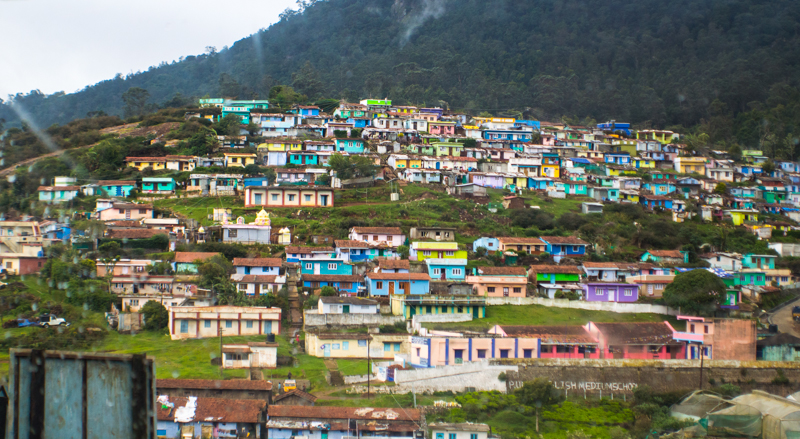
I caught a bus to Kotagiri town. Strangely, the weather dramatically changed from persistent wet weather to dry and sunny. The road is dotted with colourful and picturesque villages and tea plantations. Tea pickers were busy harvesting. In some places, the smell of tea brewing wafted through the air. I wished I could stop to capture some pictures of these quaint villages. In some villages, the colours were matched and in some houses were arranged (designed) as containers with advertisements on them. All nestled in emerald green tea plants. Kotagiri (1847m) is the hub in these mountains and is the oldest hill station in the Nilgiri Mountains. As with hill towns, just over the main dusty road across the bus station, the land drops into a valley. Homes and tea plantations flourished. It is fresh and green here. My destination, however, is another 20km away. The road became narrower as my local bus driver swerved the bus to avoid domesticated animals and traffic. With him keeping an eye on the road, I savoured the wonderful valley, colourful villages and stunning mountain views.
The weather suddenly changed to cloudy and the wind picked up. Kodanadu Viewpoint – ‘The Galaxy of Nature” panoramic view, was now completely engulfed in mist. Very cold and raging wind swept through. Like in Dodobetta, there was no view here either. I and a few hardy souls braved the strong wind and wandered (more like carried around by the wind). Trees and shrubs slanted to one side. Notwithstanding, I hurried into a small but cosy shop. Yes, nice cup of hot Indian tea and few snacks kept me warm. This shop is run by a congenial ethnic Toda couple – Shankaran and Sivarani. The Nilgiri mountains are populated by several tribal people. The spoke Tamil to me and had their own distinct language. I looked out of the cold wind. The wind had not died down. In a way, it was mystical and very primordial.
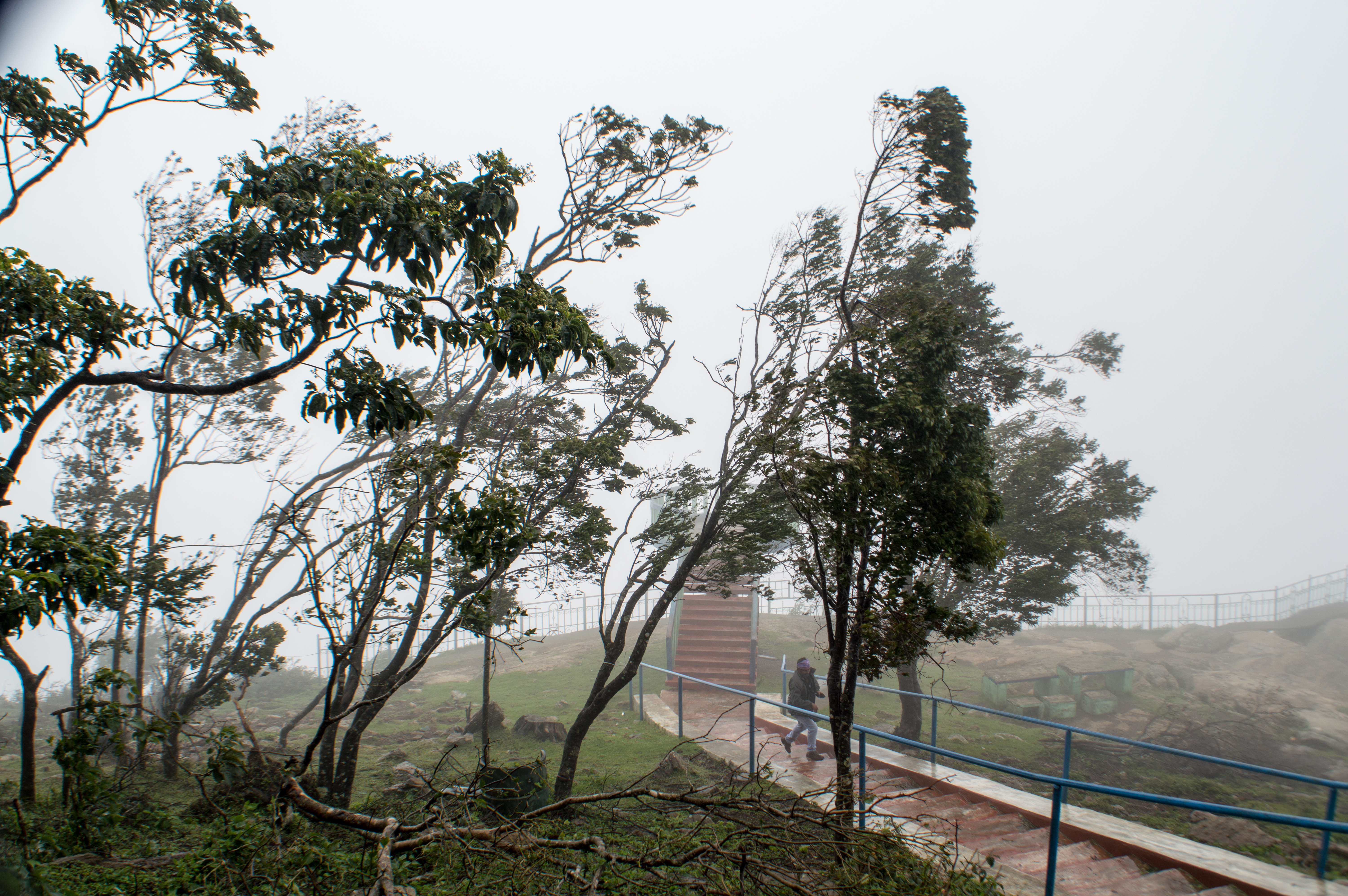
The wet weather was expected but hopeful there might be a break. The journey to world’s end was not in vain. On the way out, the bus driver decided to have a break. I was the only passenger. Well another cup of tea, perhaps. Later, we passed a signage – Avanashi Village, another ethnic tribe.
From Kotagiri, I decided to take another bus to Coonoor and complete the loop. The road snaked downhill, just slow enough to admire the fantastic picturesque village views. Coonoor was still wet. I broke the journey to get lunch. However, all the eateries and shops were closed. This time, I was told, a former Indian President had died. Not again, I thought about all the commotions with Karuna Nidhi, former Tamil Nadu Chief Minister. My umbrella came in handy as I rushed into another bus back to Ooty. I enjoyed the journey with wonderful views. In fact, the bus ride was comfortable and offered some thrill of looking out of the window and seeing a few hundred meters drops.
Tip – In hindsight, a personal drive would have been much more rewarding. Just to stop wherever, chat with locals and enjoy the views.
18/8 – Ooty
This morning, the persistent had stopped. The ‘perpetual mist vanished’. I took the opportunity to wander around town and the markets. Ooty in a nutshell is dirty and drains are clogged with rubbish. The markets, like all other places, is buzzing with activities. The town especially near the market and bus station as expected is crowded. On a main street, I met three ladies carrying a familiar bag – Pothy’s. I enquired. Yes, they had been shopping in the markets. Again, speaking the language had made this journey more meaningful.
I boarded the bus to Mysore. However, I was re-thinking my possible visit to Mudumalai Tiger Reserve. Unprecedented rainfall with extensive coverage from east coast to west coast had brought many difficulties. Flooding and landslides had shut some major roads inhibiting access. This included Mudumalai. I could not get clear answers. Both the green Tamil Nadu and beige Karnataka states buses operated this route. The immediate difference is the language – the driver and conductor spoke Kannada – another Dravidian language. The bus ride wound its way out of the mountains and manicured tea plantations into warmer and drier valleys and lowlands. It was mostly rural. We arrived at Thepakkadu, the entry to Mudumalai Tiger Reserve. I noticed some local tourist at the ticket office. They as Indians do, were boisterous. Perhaps, the park is not affected. Is over-night accommodation available? However, it would certainly have been a noisy ride around the park (organised bus within the park). I was still keen, in my head. Along the dense teak forest of the Nilgiris, I spotted deer, peacock and macaques. Perhaps, I might regret my decision. Mudumalai is connected to Bandipur Tiger Reserve.
An interesting observation – this is the border between Tamil Nadu and Karnataka states. Up to this point, only seated passengers were permitted. Beyond this point, standing is allowed! The moment we left Thepakkadu, the driver turned on the music, loudly, blared away Kannada songs. Is there a regulation between these two states? Karnataka state seemed tidier. I can sense deep division and rivalry between these ethnic groups. Its utter nonsense! Hence, although majority Hindus, why Indian will never be united as ethnicity, language and history is deeply rooted.
18/8 – Mysore, Karnataka
The Cauvery River, a holy and lifeblood of Karnataka and Tamil Nadu, was overflowing and our bus was re-routed to take a more rural journey. Fields irrigated by canals were on the brink of flooding. We passed sunflower, Chrysanthemums, Turmeric and Cotton cultivation. It was late afternoon when I arrived in Mysore or Mysuru. My accommodation – Mansion1907 was in a quiet Nazarbad area. I was starving. I hit the laid-back streets nearby and found Hotel Mylari (“with no branches and is the original one”). Hotel in India can refer to restaurant. There is another Mylari across the street? It was fulfilling – hot thosai and tea. It also gave me a chance to get my bearings of Mysore. I walked further up the road and saw a street vendor cooking up fried spicy corn fritters. It was quite good. He continued to give samples of other cooked food too. Surprisingly, I ate everything. I eat more when I passed a stall with an assortment of Indian delicacies, including sickly sweet ‘jalebi‘. Hot from the frying wok. I spent all evening relaxing at the accommodation and wandering the streets with no particular place to go.
19/8 – Mysore – Somanathpuram
I ordered breakfast with a lodge’s caretaker. Her speciality – Ragi Dosa with potato bhaji and coconut chutney. Yum! Last night, at the lodge, a local tourist informed me about Somnathpuram. He said it is very impressive. However, it is out of town. Well, I decided to check it out. From a nearby bus stop, I headed to Bannur Village. Then, another local bus took me Somanathpuram. The transit time is uncertain. The driver dropped me off the main road and a 100m walk brought me to the Keshava Temple on the banks of the holy Cauvery River – “Ganges of the South”.

As I stepped into the first mandapa, I was immediately struck by the magnificent sight. Intricate and detailed carving of gods, goddess and demi-gods, humans and animals. All in minute detail. The raised platform, ‘jagati’, is shaped like a star. Amazingly, the gopuram also followed the same lines. How did the builders manage to get the symmetry, geometry and alignment so accurate? To add to this wonder, the exterior is so intricately and delicately carved right down to toes and fingers. This is a 13th century temple dedicated to Vishnu. All the significant statues inside the temple were destroyed or damaged by the invading Muslim armies, twice!



Even the exterior was not spared. Putting religion aside, one must wonder the ingenuity, skill and planning that must be accurately applied to create this masterpiece. This is the pinnacle of Hoysala, the ruling dynasty, architecture. Sadly, this temple is no longer used for worship. It took 68 years to build. It is not one piece. The labour and mechanism required to polish the pillars and ornate carvings would have been enormous.
On the exterior lower panels, stories of the Ramayana, Mahabharata and Krishna (Bhagavat Purana) is pictorially carved out in stone (soapstone – soft when underground but hardens once exposed). I love the story about the “cosmic ocean”. Follow the circumbulation direction – clockwise manner. The reliefs include common life scenes and sexual scenes, “kama mithina”. I kept going back to the carvings again and again, probably three times. There are thousands including images of Vishnu, Brahma and Krishna. A guide would be valuable. I am glad to have made this out of town journey. Simply stunning, set in a rural landscape surrounded by coconut trees and paddy fields.
After lunch, I headed into the city’s Devaraja Market. I love markets – the produce, colours, the people, the language (and antics) used in buying and selling, the smell and sound. It was a bustling. Outside the market, fruit and sundries vendors displayed their wares. A sweet seller enticed me to buy, not that I needed an invitation. The aromatic flower market was full of activity with vibrant colours. The energetic vendors competed to vie for customers. Even in the warm afternoon, the sweet scent of fresh flowers was unmissable.
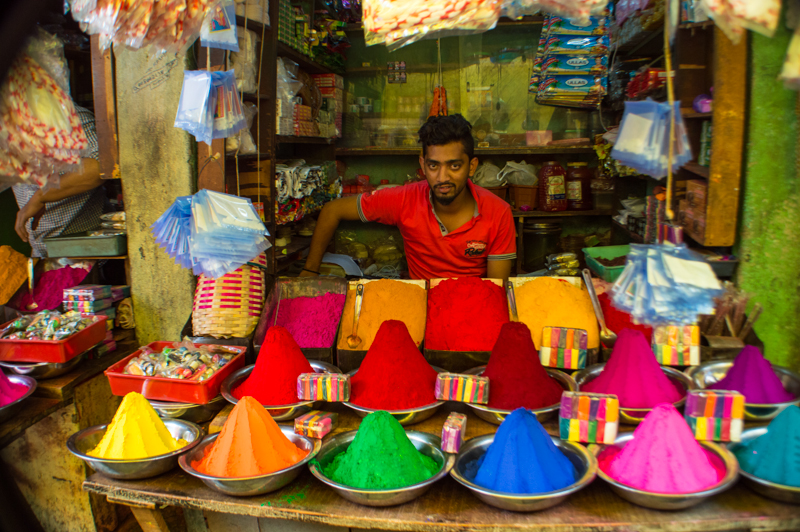

A few spice vendors, vegetable and fruit sellers were tucked into this crumbling building. Tarpaulin stretched over the top, some in tethers, provided some shade from the elements. A young man, sat behind cones with vibrant colours and vivid hues of “kungumam” pigments – synthetic and natural?
Being a Sunday, I headed out to the iconic Mysore Palace to catch the evening light and sound show. However, I was disappointed to find that it would not be illuminated for the whole week. This is to mark respect for the former President whom passed away recently. I had dinner at Roopa Hotel (5th Floor). Viewed from the roof top, the palace was dimly illuminated. Just walked around another part of the palace viewed from the road. Full illumination of the palace is a highlight in Mysore. Not today though.
20/8 – Mysore
This morning, fellow lodges mates decided to follow me to Chamundi Hills. We caught the bus up the hill. It climbed a 1000m through a winding road. At the top sits the over 1000 years old Chamundeshwari Temple. Its seven storied ‘gopuram’ is built in typical Dravidian style. It was crowded. As with all temples, there are stall selling prayer materials and souvenirs. Sometimes it felt like a carnival atmosphere. Temple ushers managed the crowd by moving the devotees along with shouts. Sometimes physically. It was the same inside the inner sanctum. There was “no meditative state of mind”. Just fulfilment.

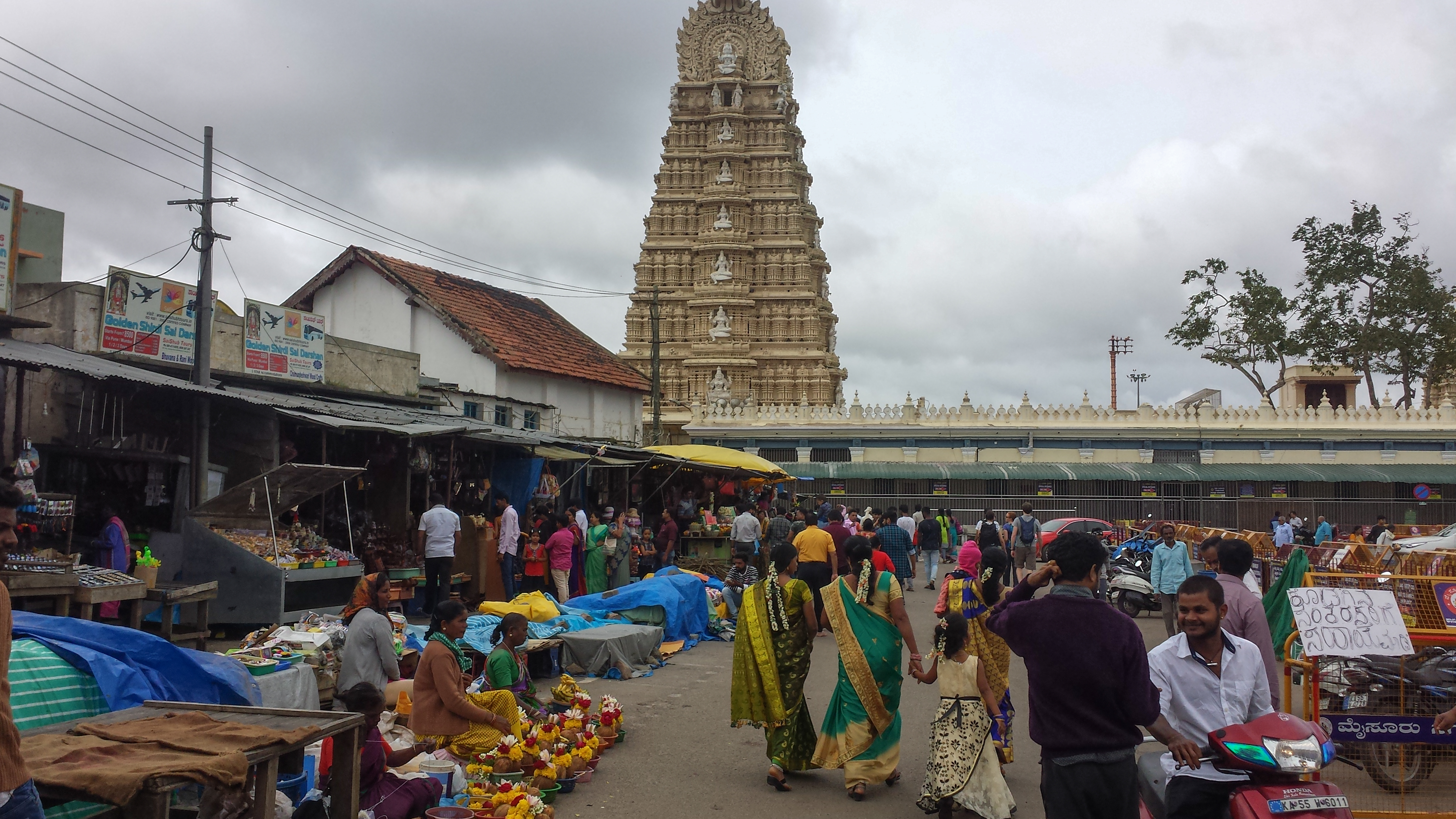
On our return, we decided to walk down the 1008 steep steps. Several girls dutifully put the traditional “manjal” – turmeric and red “Kungumam” – Kumkuma. This is typically put on the forehead. Understandably, not many people used these steps. At the mid-way point, is a huge Nandi (bull). At the bottom, transport was scarce. In the city, we managed to find a South Indian restaurant, Cafe Arame. A satisfying way to end the afternoon.

After organising an out bound train tickets at the central train station, we headed to Sultan Tipu’s Palace in Srirangapatana. We hired the iconic Ambassador car. It is of British origin but later Indianized with minor changes. It’s a classic. Srirangapatana is an island created by the holy Cauvery River. Tipu Sultan’s Summer Palace – the Dariya Daulat Palace is on this island. The fort palace was wrested by Tipu’s father, Hayder Ali from the Wodeyars dynasty. Before that, the Vijayanagar and Hoysala dynasties. The sprawling grounds are maintained by a small army of hard-working workers. It is an impressive site – doorways with Islamic inspired arches, wooden balconies and pillars – mostly made from teak. Walls are covered with murals, painted fabrics and paintings – depicting everyday palace life. Even the ceiling is covered in these magnificent paintings. The Jumma Mosque, now a museum, is walking distance to the palace. Quite easily located by two rising minarets.
Our driver waited for us as we had no transport planned. He then took us to Sri Ranganatha Swamy Temple. It was built in 894 AD. Since then, all the ruling empires had made some form of structural changes including Hayder Ali, a Muslim. It is considered a holy place by virtue being on the Cauvery River. We returned to Mysore. That evening, we all returned to Roopa Hotel for dinner. Its been a good day out.
21/8 – Mysore
This morning we headed to the Mysore Palace (Amba Vilas Palace)– the seat of the Kingdom of Mysore (circa 1399). Although a palace existed earlier, the current one was built in 1897 during the rule of Krishnaraja Wodeyar IV. The Indo-Saracenic architecture is built with a mixture of the Hindu, Mughal, Rajput, and Gothic styles. We entered the palace through the South Gate. I was disappointed with the closure of the light show on Sunday. Nearly 100000 lights illuminated the palace highlighting its majestic exterior appearance.
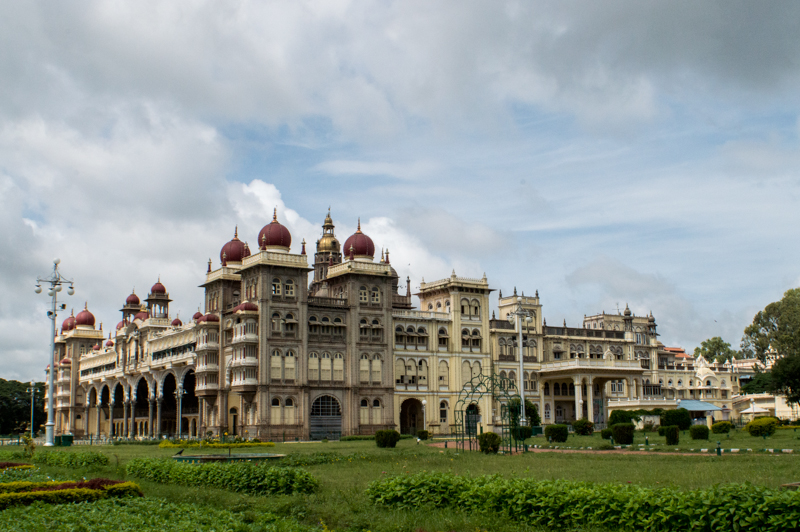

We walked through a sprawling and expansive garden which surrounded the magnificent palace. The Moorish maroon domes, the tall pillars and decorated arches caught my eye. Only when I entered the palace did the magic of opulence and lavish lifestyles of the rulers appeared – the painted wall murals and long corridors with ornate arches. Finally, a hall opened. Tall sculptured and vividly painted colonnades in gold and blue. At the centre, a glistening chandelier hung from the stained-glass ceiling. Colourful tiles decorated the wall and floor. I arrived at an open courtyard surrounded by ornately designed windows and cast iron spiral staircases.
Mysore Palace is the second most visited site after Taj Mahal in India. The theme continued to two other beautifully decorated halls. Rows of soft blue and gold ornate pillars seems to go endlessly like looking at a mirror reflection (Darbar Hall). This is topped-up with exquisite and lavish furnishings and artworks. I loved the intricately carved wooden doors and mosaic floors. Yes, the maharajahs certainly surrounded themselves with luxury.
The museum was fascinating. However, there is a small temple, Prasanna Krishnaswamy Temple with some magnificent wall murals. The colours were well preserved. The priest though, said “no pictures!”. Facing the palace, on the perimeter wall, is the Trinesvaraswamy Temple.
21/8 – Bangalore
This afternoon, I took the train from Mysore to Bangalore (Bengaluru), the capital of Karnataka. It is a modern city. In the evening I headed to a popular street food area called VV Puram. I arrived here by auto driven by a South Indian. He said, the Kannadigas and Tamilians don’t get along very well. They are threatened by them taking up local jobs. The street food stalls were already buzzing away. I tried to sample in various stalls. It is a great place to get varieties of local food. I found it difficult to return to the city as the local auto drivers charged exorbitant rates. Perhaps, they figured I was South Indian. Eventually an auto driver stopped, and he turned out to be a South Indian. Sadly, divisions along ethnic lines run deep.
22/8 – Bangalore
Today is my last day in India before departing for Malaysia and onward to NZ. To make to most of the day, I left early to visit the popular Lalbagh Botanical Gardens. The day was cloudy, and the garden was a good start for the day. Not as impressive as Sim’s Park in Coonoor. I asked an auto driver if the Krishna Rejendra Market was open. He suggested it is closed due to a Muslim religious holiday. However, he suggested that I visit the shopping district. He is just looking to make some commission. I just walked off.
I headed to Tipu Sultan’s Summer Palace. The architecture is a mix of Indian and Islamic designs. Although not as grand at his palace in Srirangapatana, Mysore, it is still impressive. The structure was built entirely with teak with fluted teak pillars on stone bases. It had all the hallmarks of a palace – balconies, decorated columns and pillars and arches. It is a double storey building with reddish gilded floral motifs on the walls and ceilings. What remains is only twenty-five percent. A stone inscription read – “abode of Happiness and envy of Heaven”.
Beside the palace compound is the Kote Venkataraman Temple that predates the palace. It is said that Tipu Sultan regularly paid respects to the deities. Further up the road, I found Bangalore Fort. A nondescript building near a local market. Unfortunately, what remains is the north gate of the fort, five per cent of the original fort. In fact, Tipu Sultan’s Summer Palace, Kote Venkataramana Temple plus a few current buildings were within the fort. There is a small temple inside the compound surrounded by high wall made of stone blocks. Several carvings etched into the stone is visible and scattered on the walls. There is a dungeon and jail. Huge wooden doors hung at the entrance.
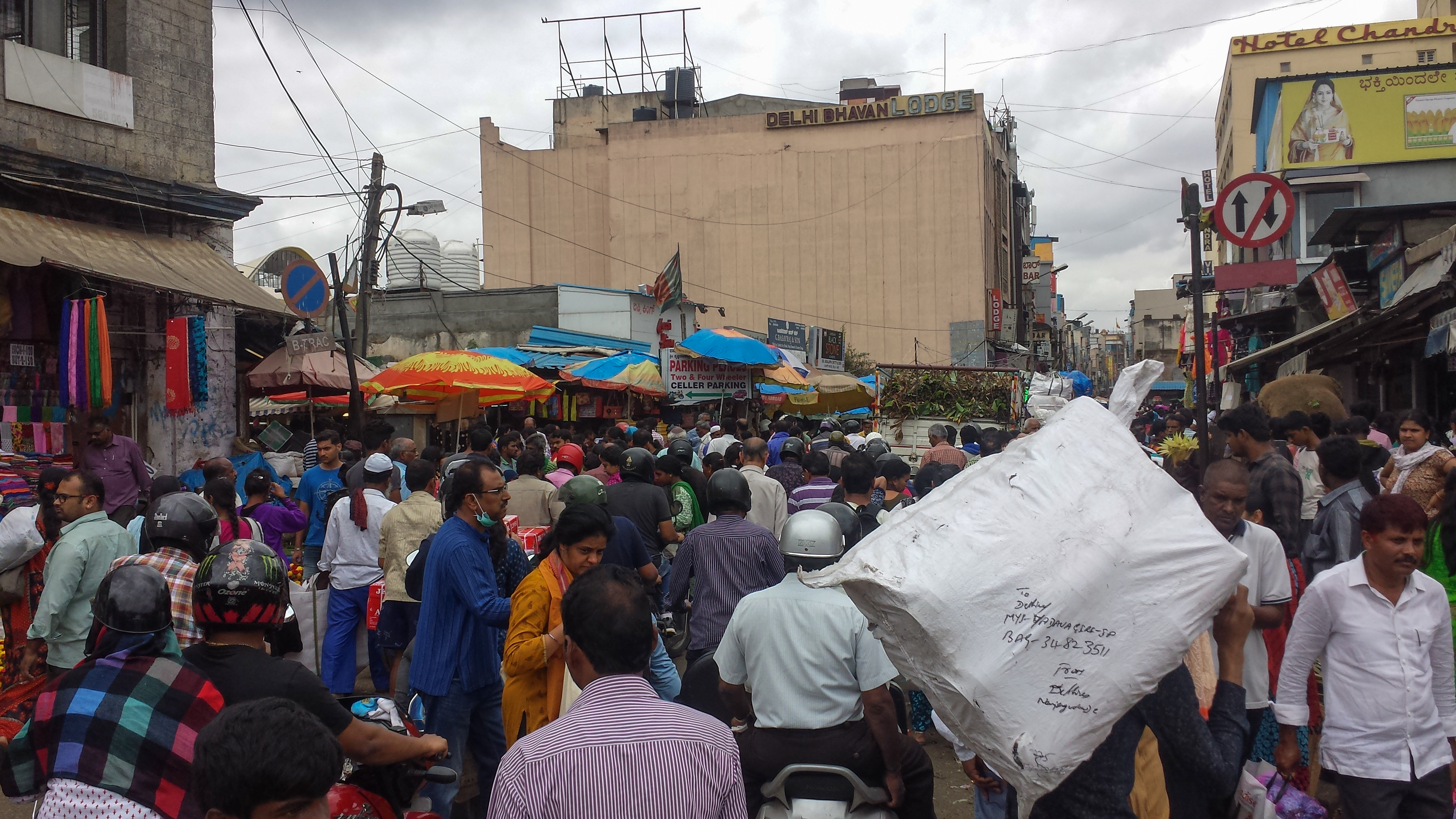
I had time with nowhere to go. I decided to wander the nearby streets. I arrived at a very busy crossroad. It was packed with people, trolleys and “walking goods”. I took refuge at a police barricade. The policeman just smiled. The road was not visible. Eventually, I threw myself into the packed street. Not long, I was “guided” towards a marketplace. I was quite excited. I had to dodge pull trolleys and porters with goods on their backs and heads. It was frantic. There were lots of people milling about amidst a euphoria of buying and selling. Sacks of dried chillies caught my eyes at a wholesaler. Herbs, whole spices and powders, fresh fruits and vegetables and more.
Every inch of the pavements is a “business centre”. I sweated profusely as I immersed myself into the crowds. I had little control in the direction I was heading. It was a river of people and goods. We came to a bottleneck. A set of steps led into a building. Bodies against bodies, baskets, bags, goods and children. There was a great deal of pushing and shoving as both in-going and out-going people collided. My direction was at the mercy of the wave. I wanted out! It’s impossible.
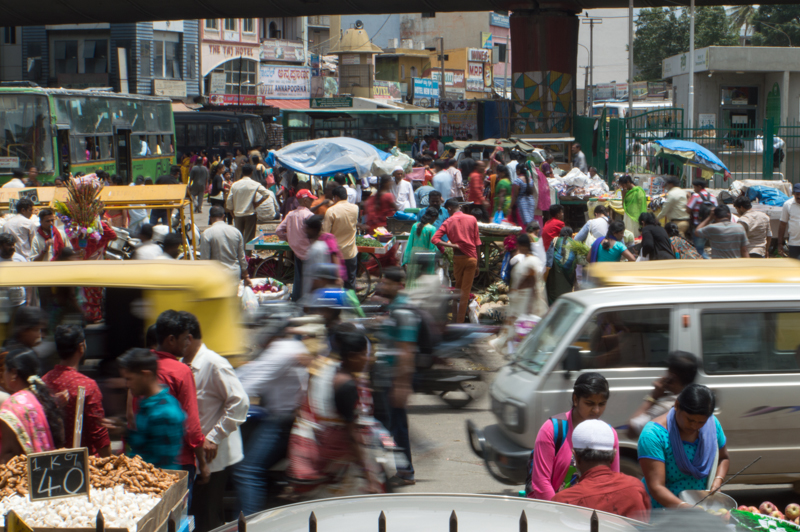
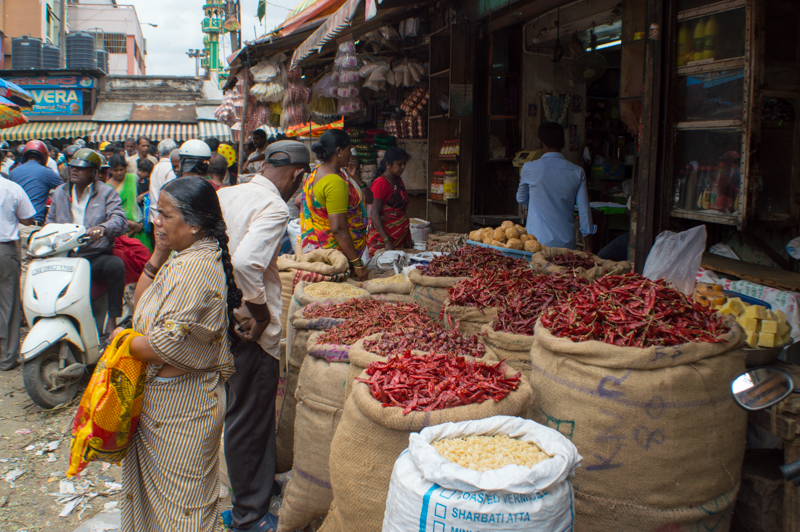
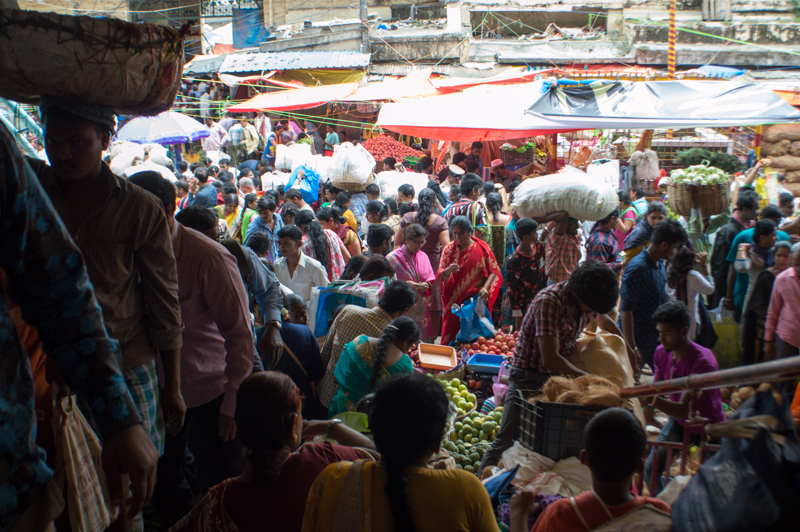
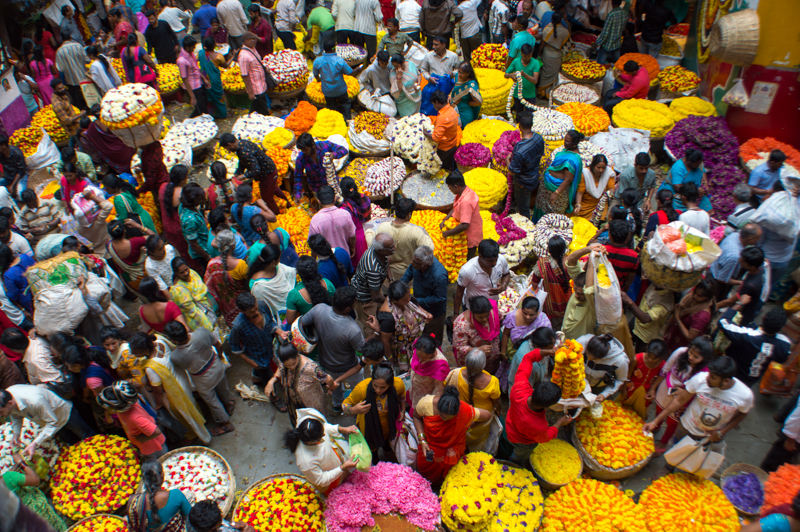
The wave dropped me into the building. I was relieved and navigated through the labyrinth of stalls. I asked someone, what is this place? They replied KR market. As my eyes adjusted to the low light, I realised I was in Krishna Rajendra market. This building is old (since 1928). The flower market is the busiest of the lot. It was frantic as wholesalers vied for customers amidst fierce competition.
Bulk fresh flowers – jasmine, gerberas, roses and marigolds, laid on the floor, beautifully weaved flower garlands hung from the ceiling, and men and women surrounded by piles of weaved flower arrangements for customers. The scent of fresh flowers filled the hall amidst sweaty bodies. I managed to get upstairs where it was relaxed and little crowd. Tea shops and sundries stalls conducted business at a leisurely pace. With a cup of hot chai, I watched the wonderfully chaotic scenes below in vivid colour. It was sensational to see streams of people flow on a narrow path flanked by heaped loose flowers and baskets of neatly rolled garlands. It was worth the effort to get in here. I loved it.
After a whirlwind experience at KR Market, I headed off the Tipu Sultan Bangalore Palace with a castle-like design and returned to the city. I had to try the “pani puri” a local snack food. After dusk, I left incredible India.
Travelling in South India has been a gentle and inspiring journey, self- discovery and self- transformation. An awakening and perhaps, even enlightenment.
